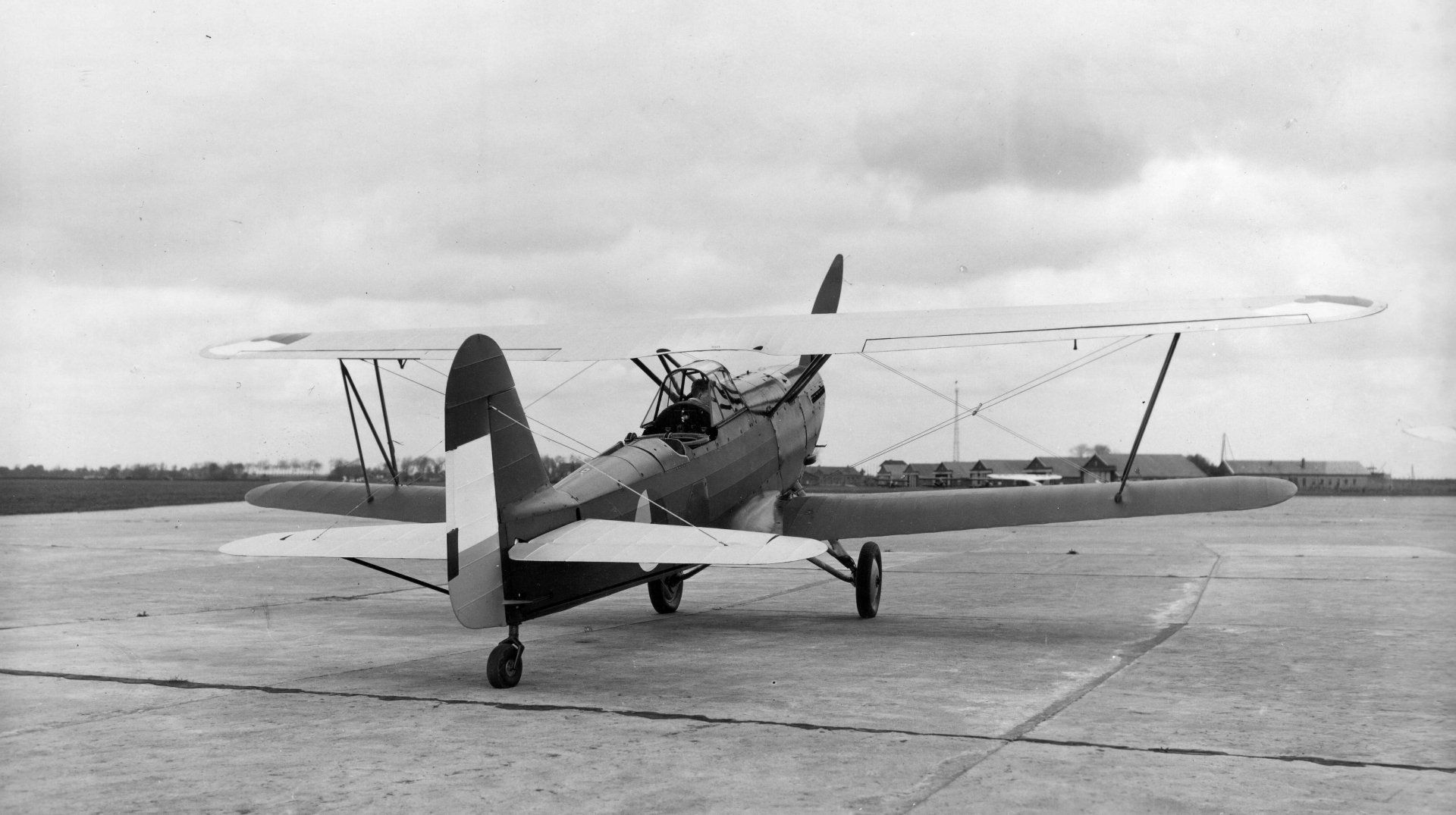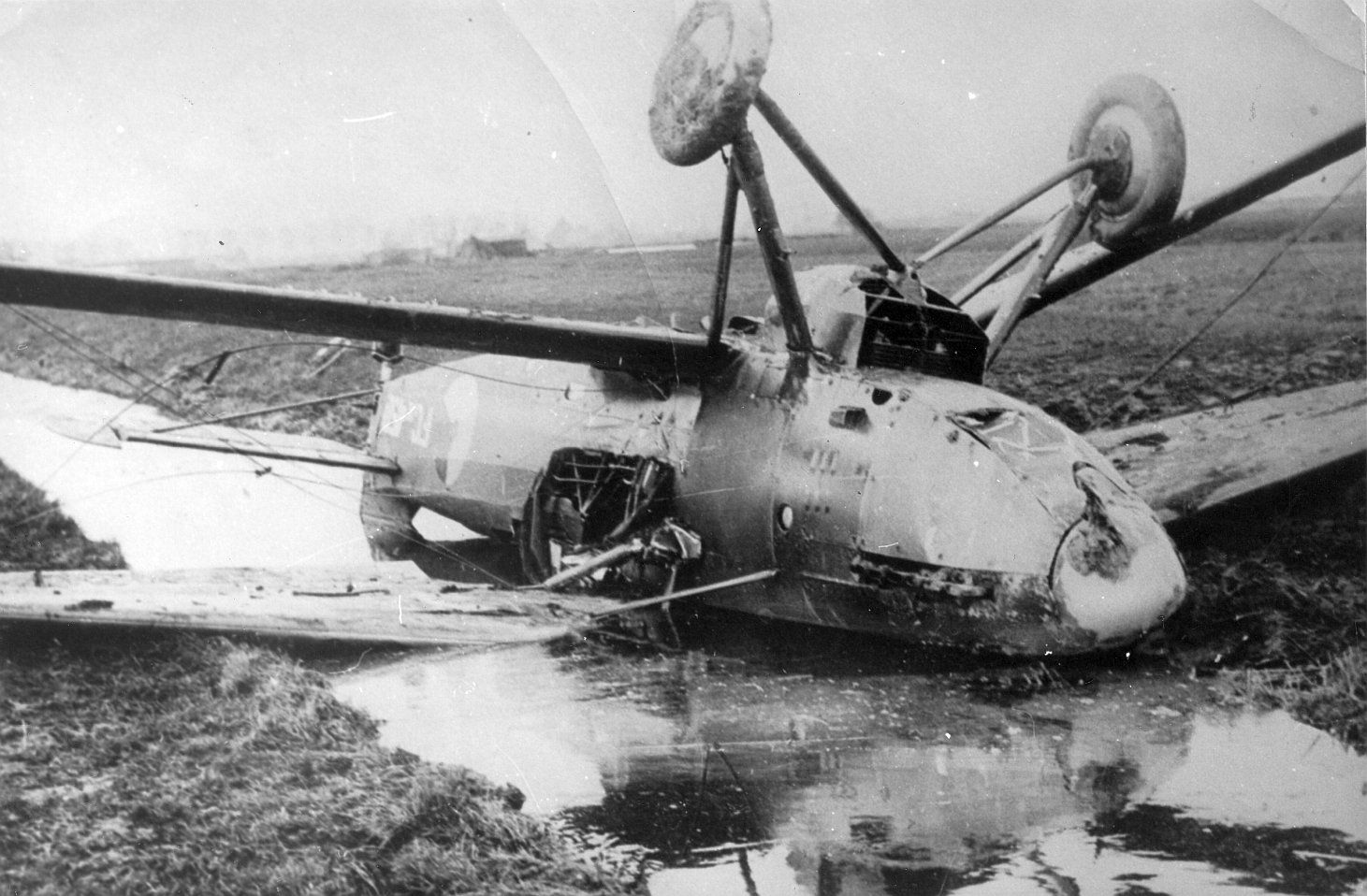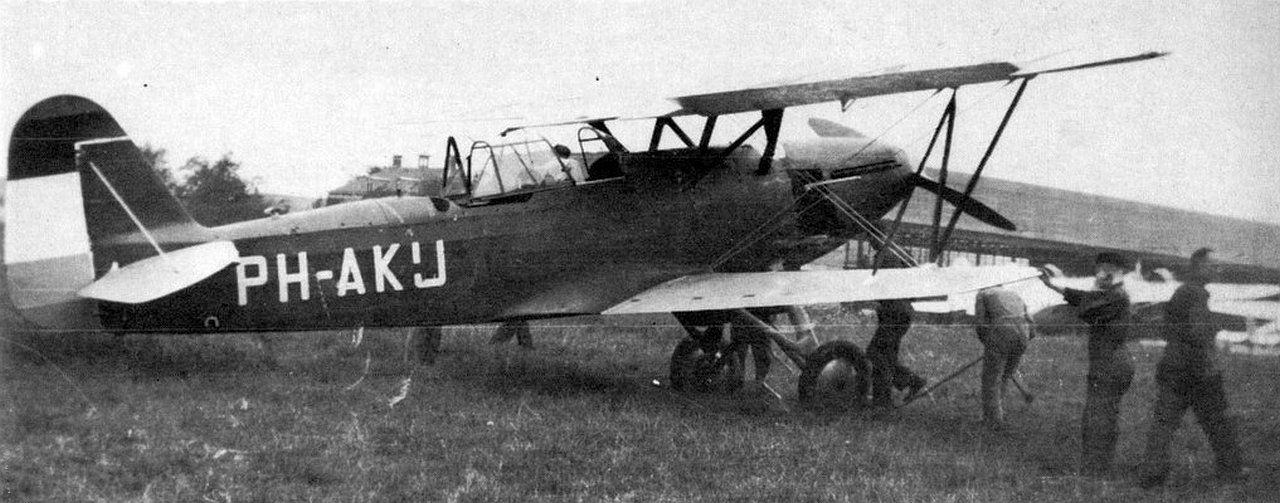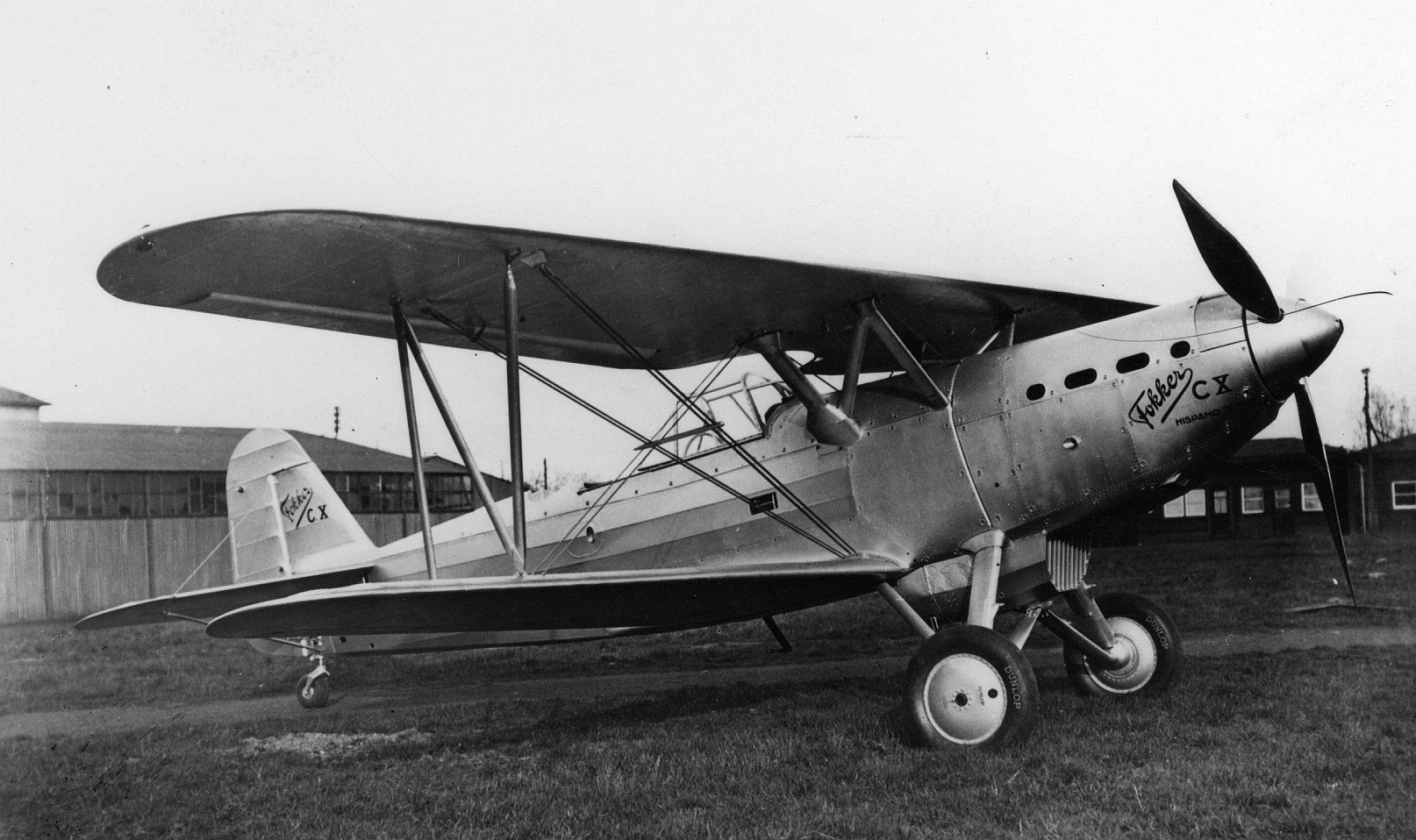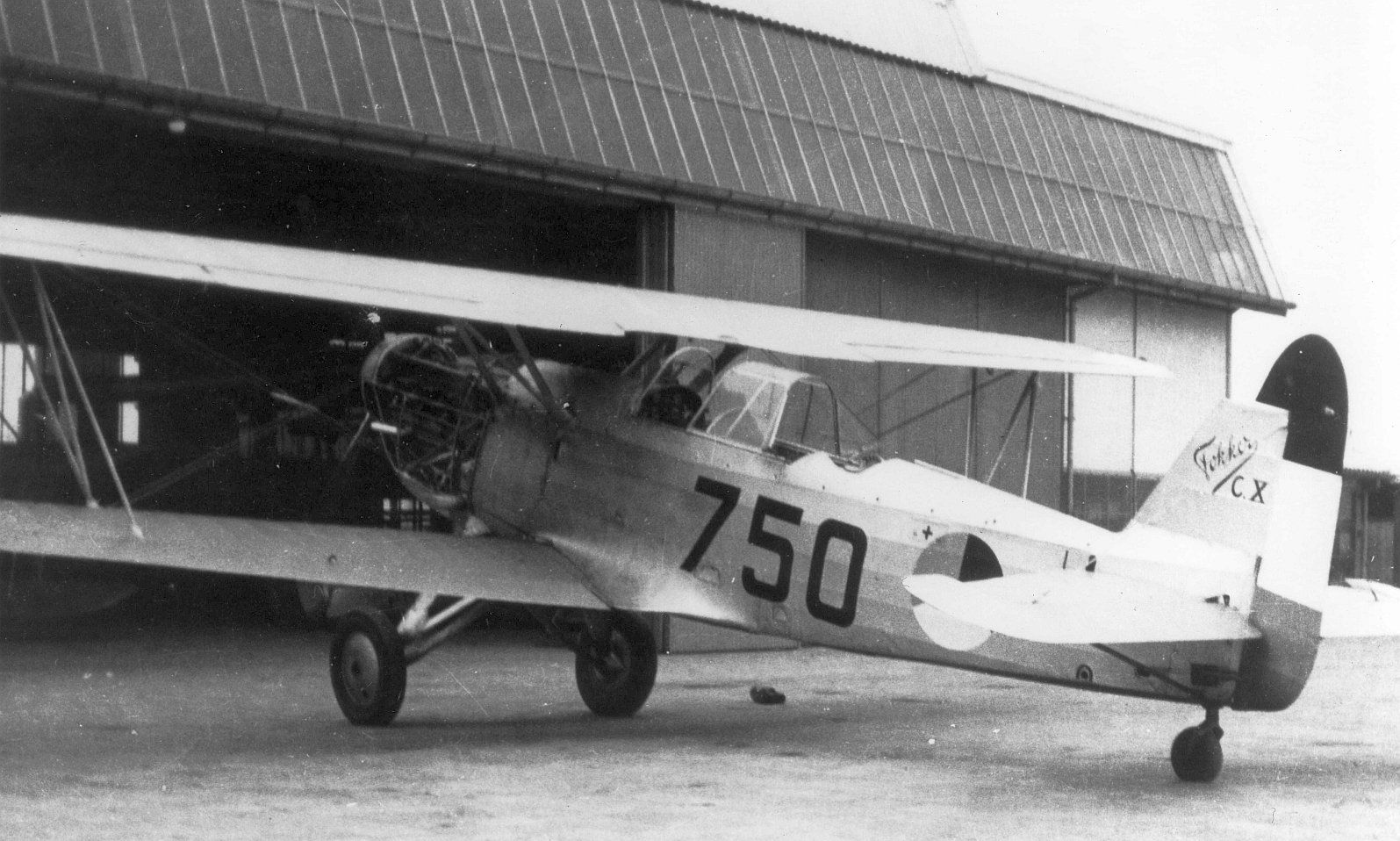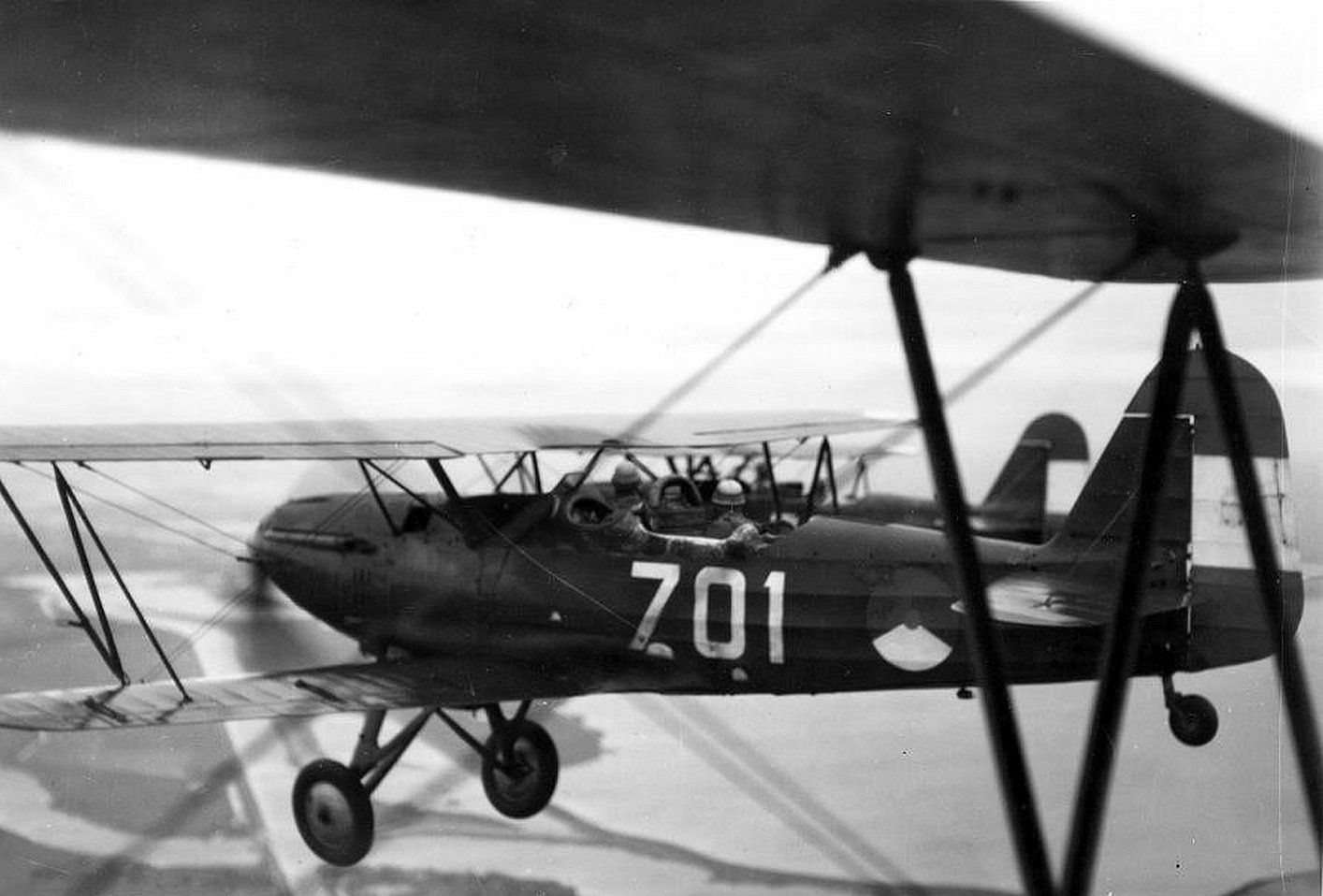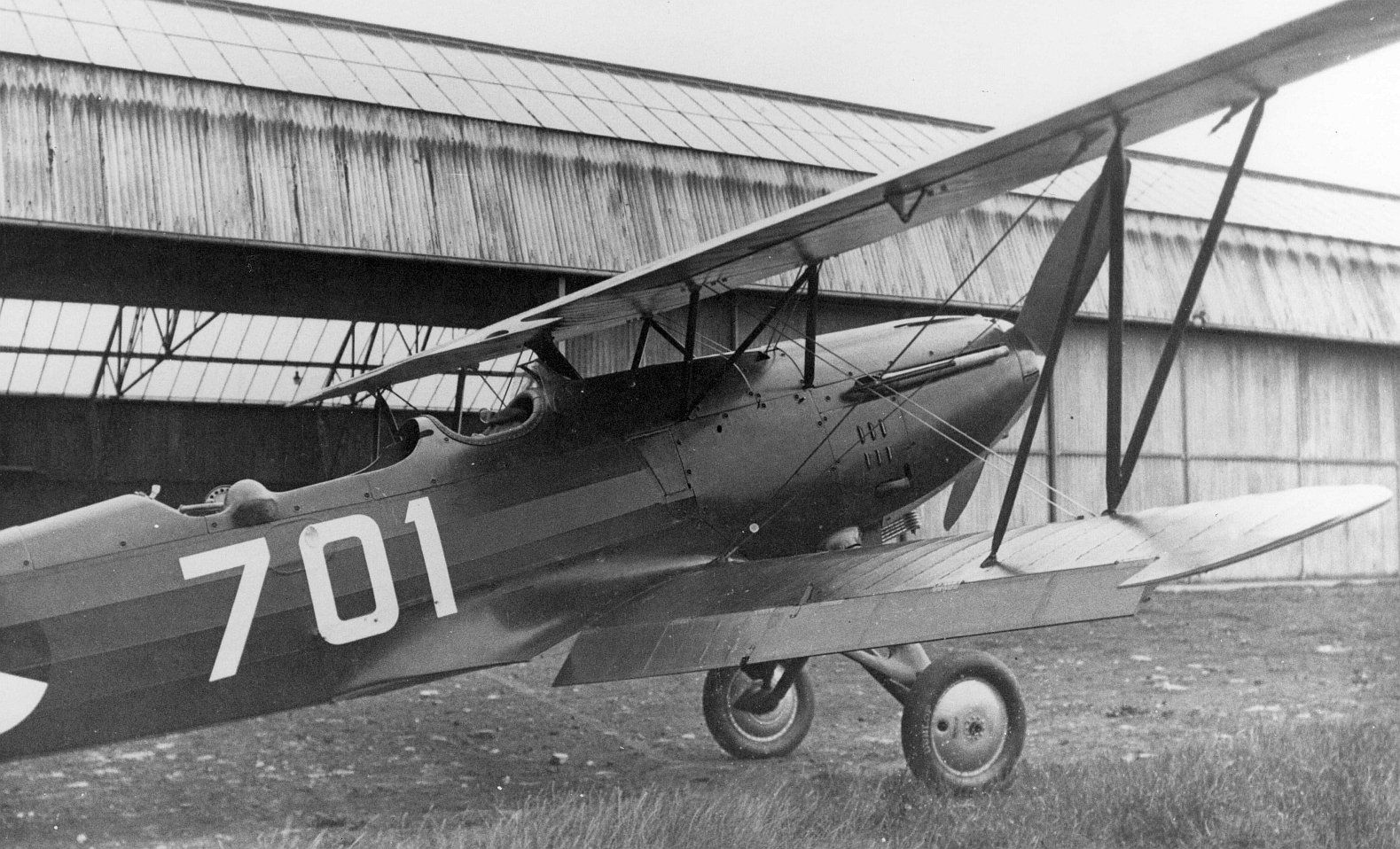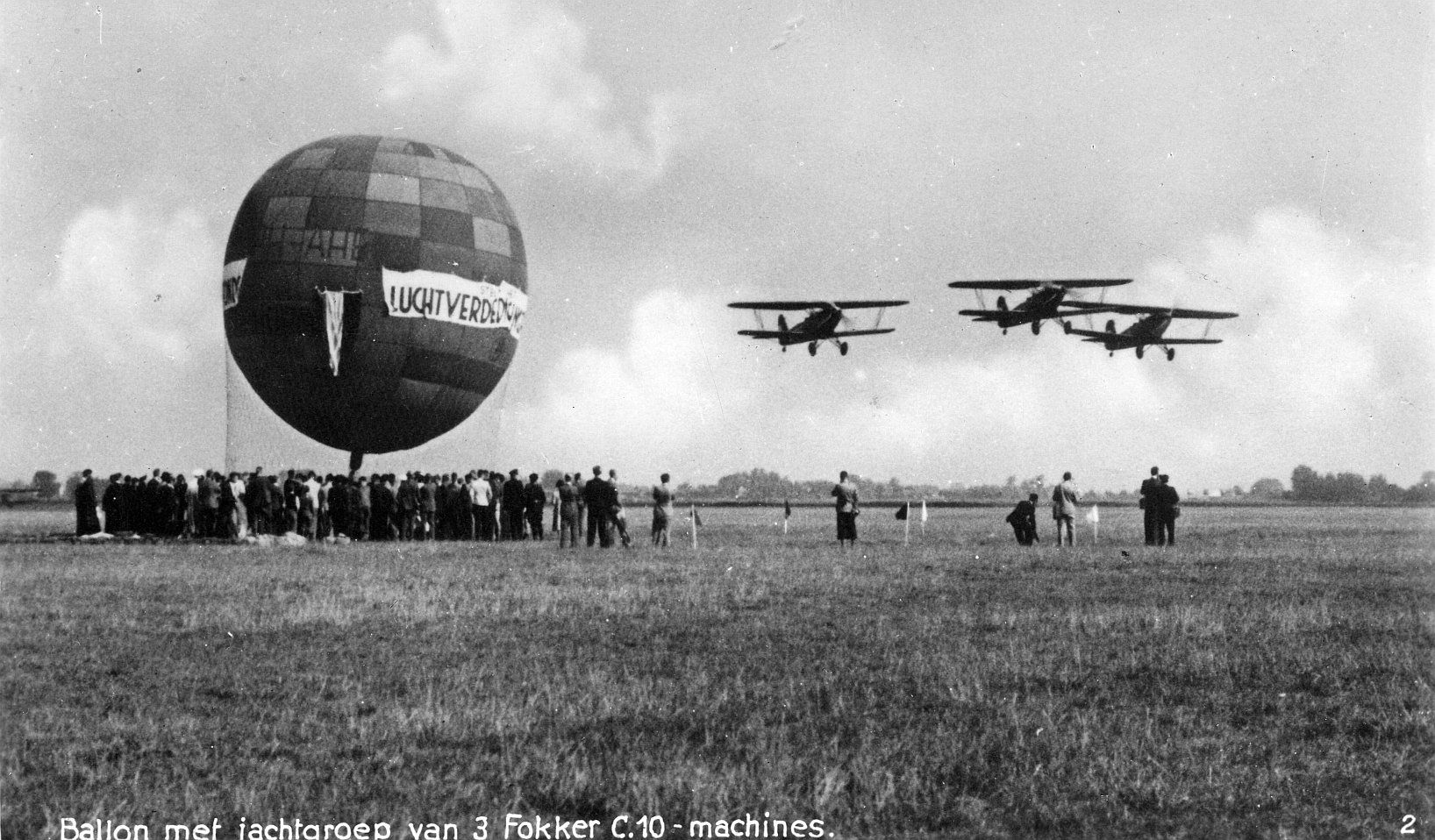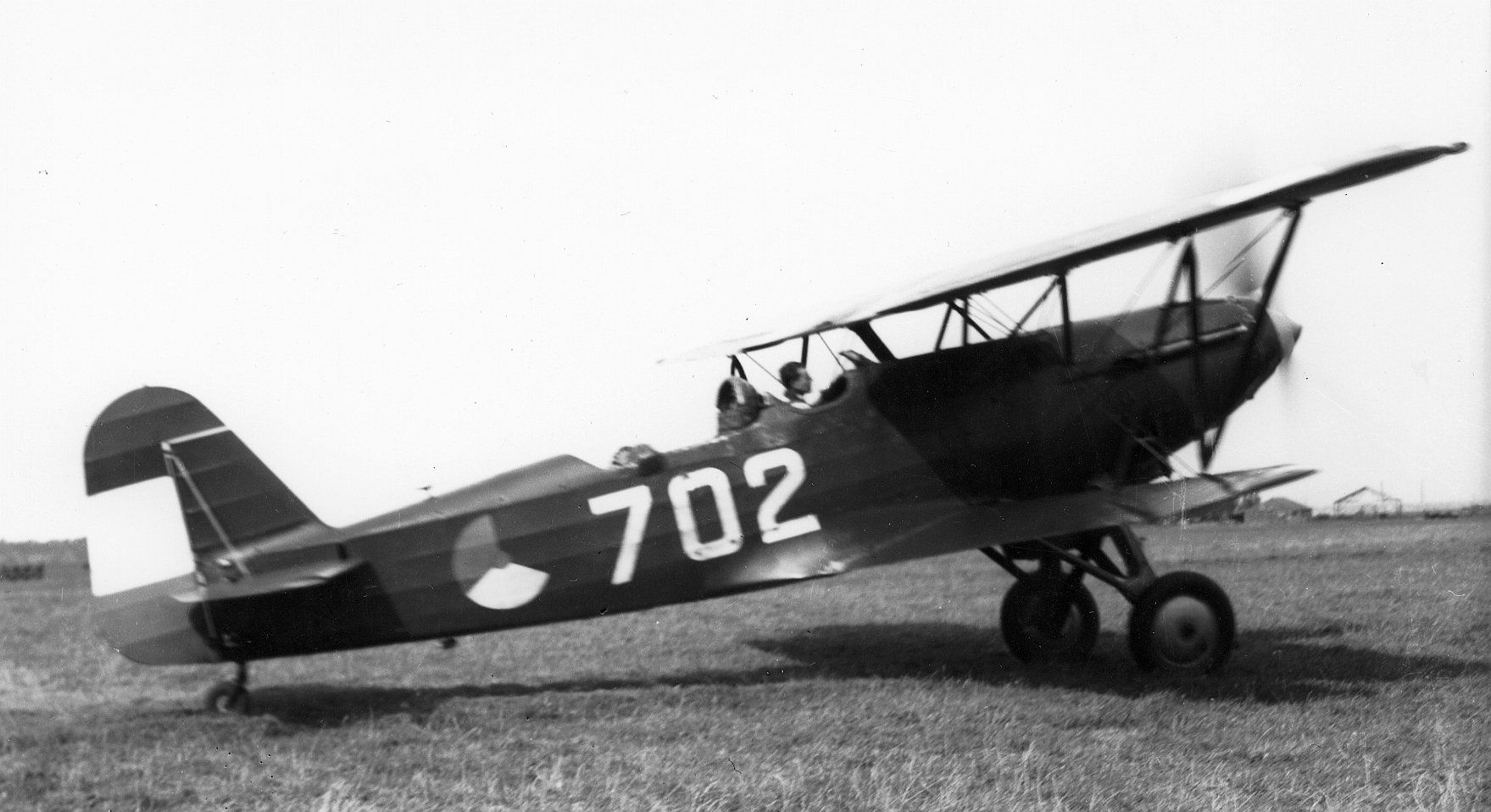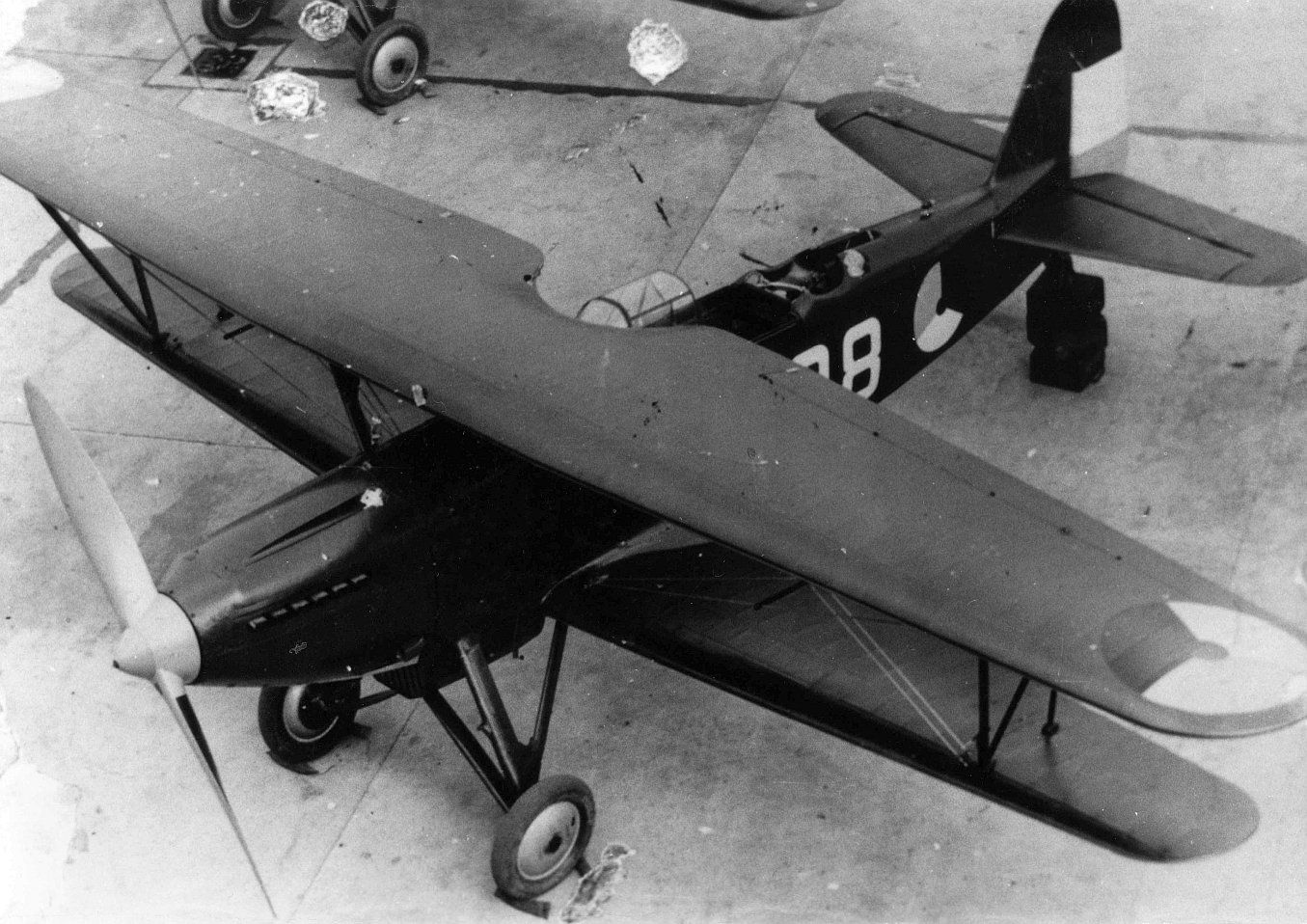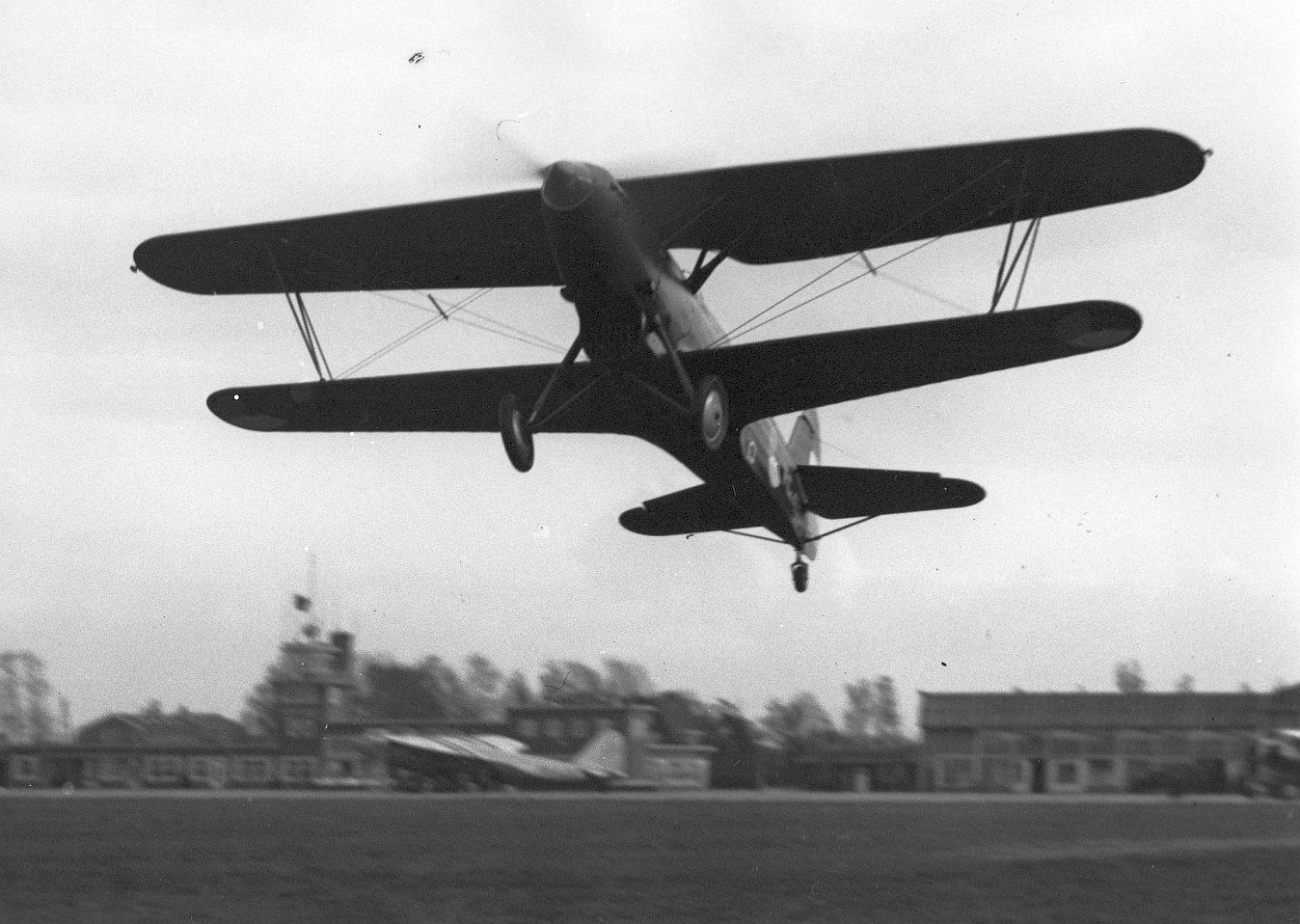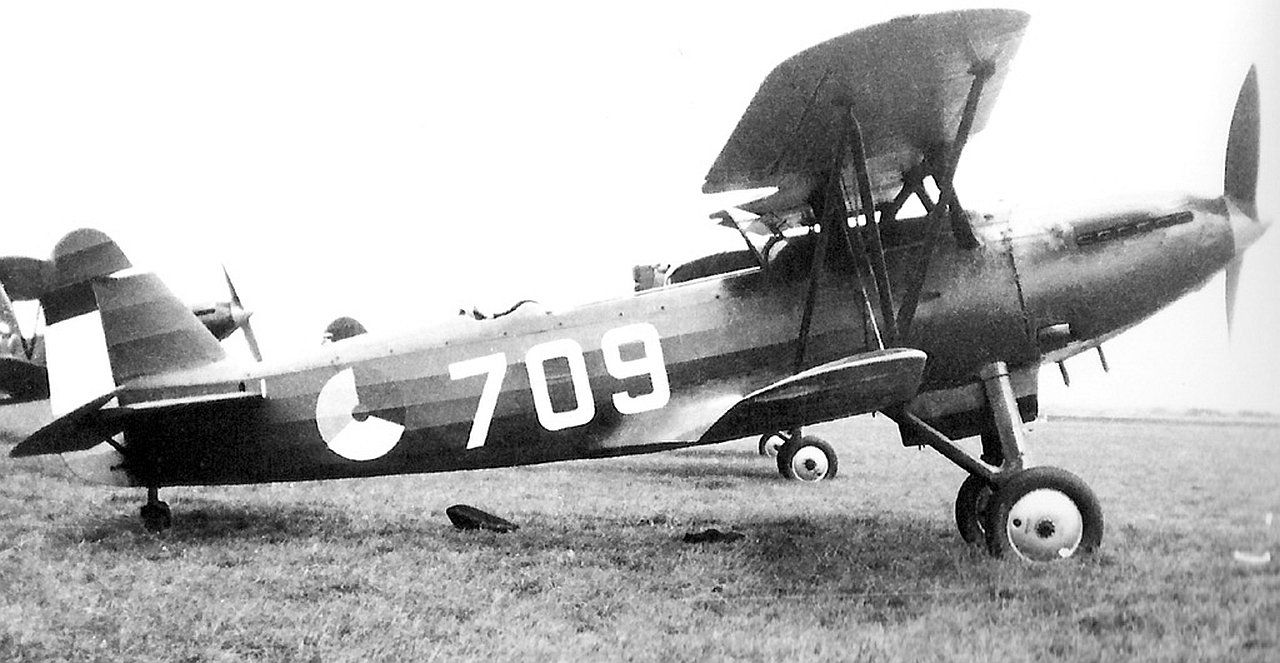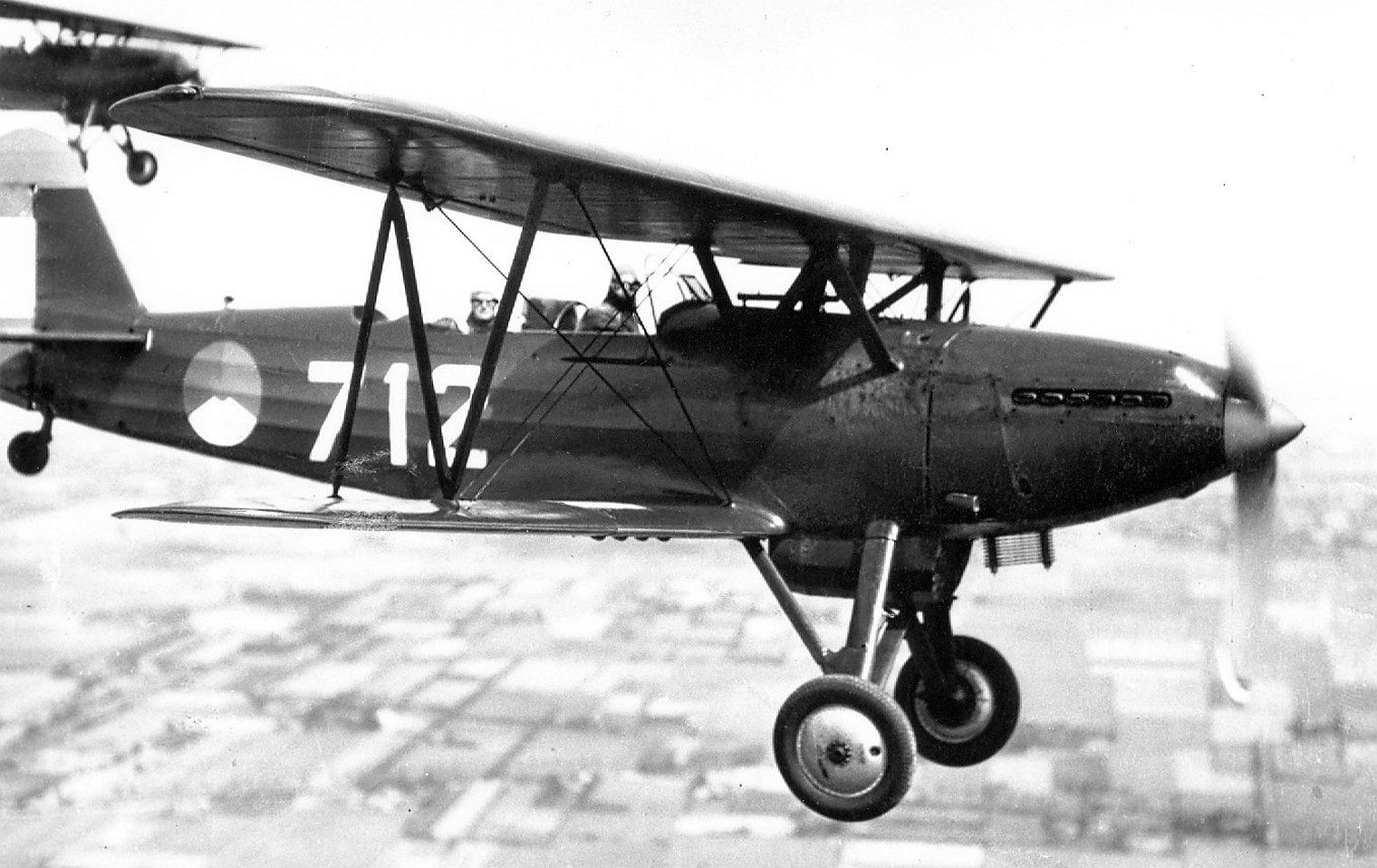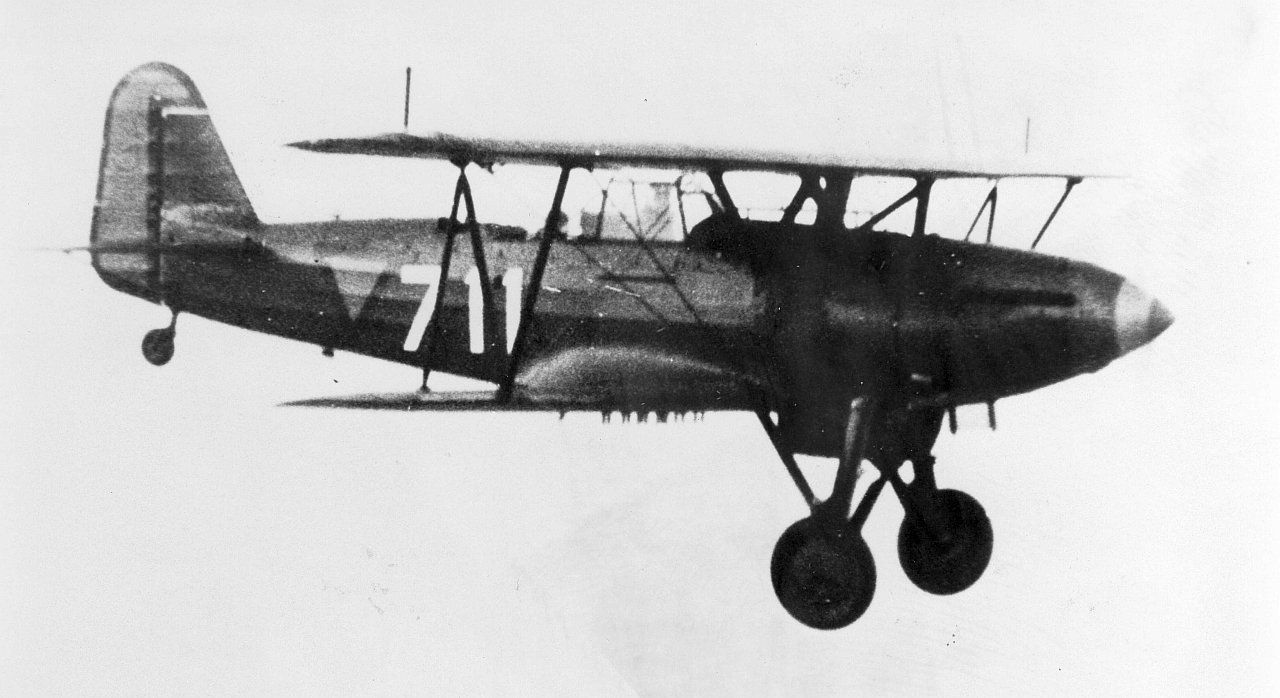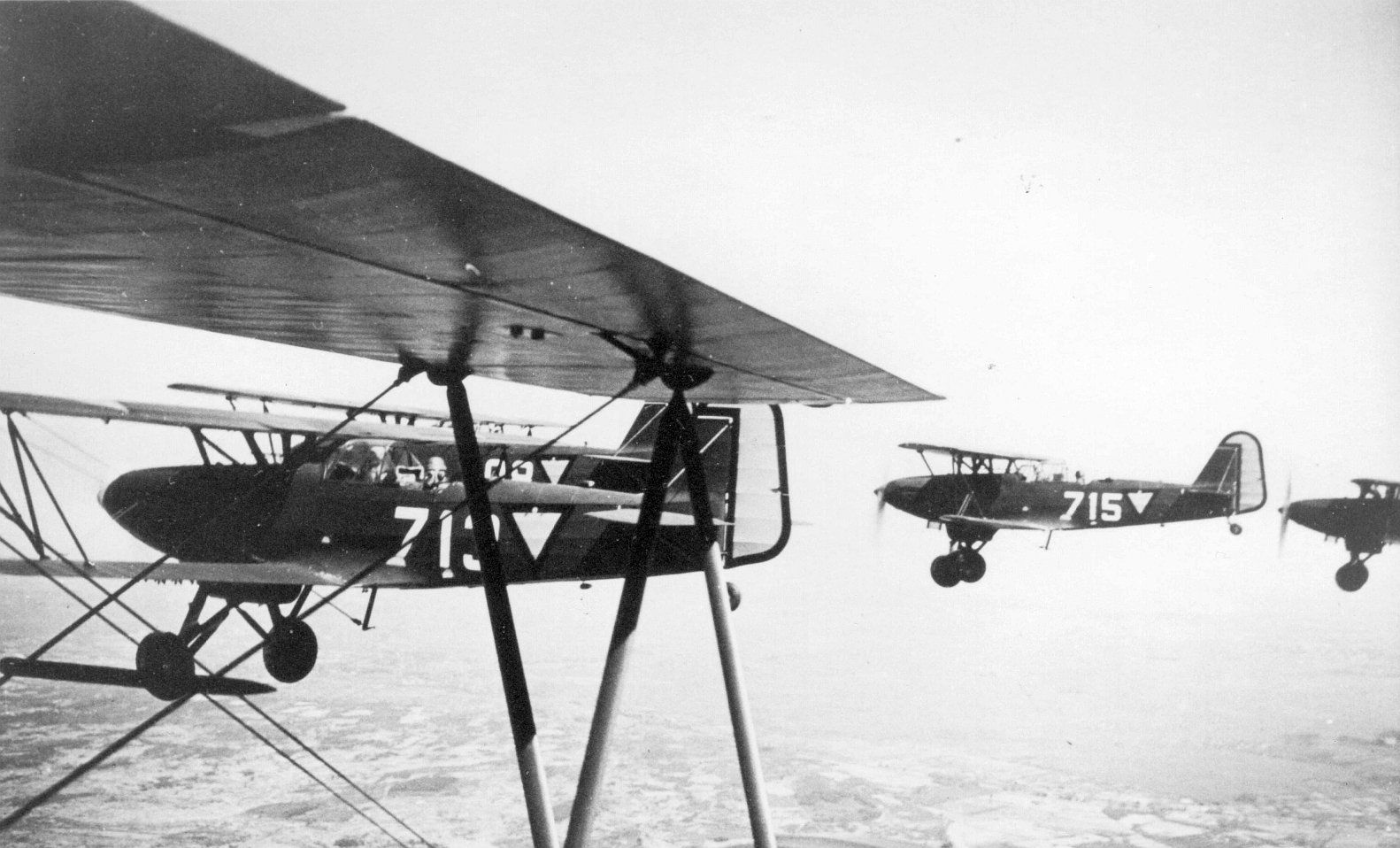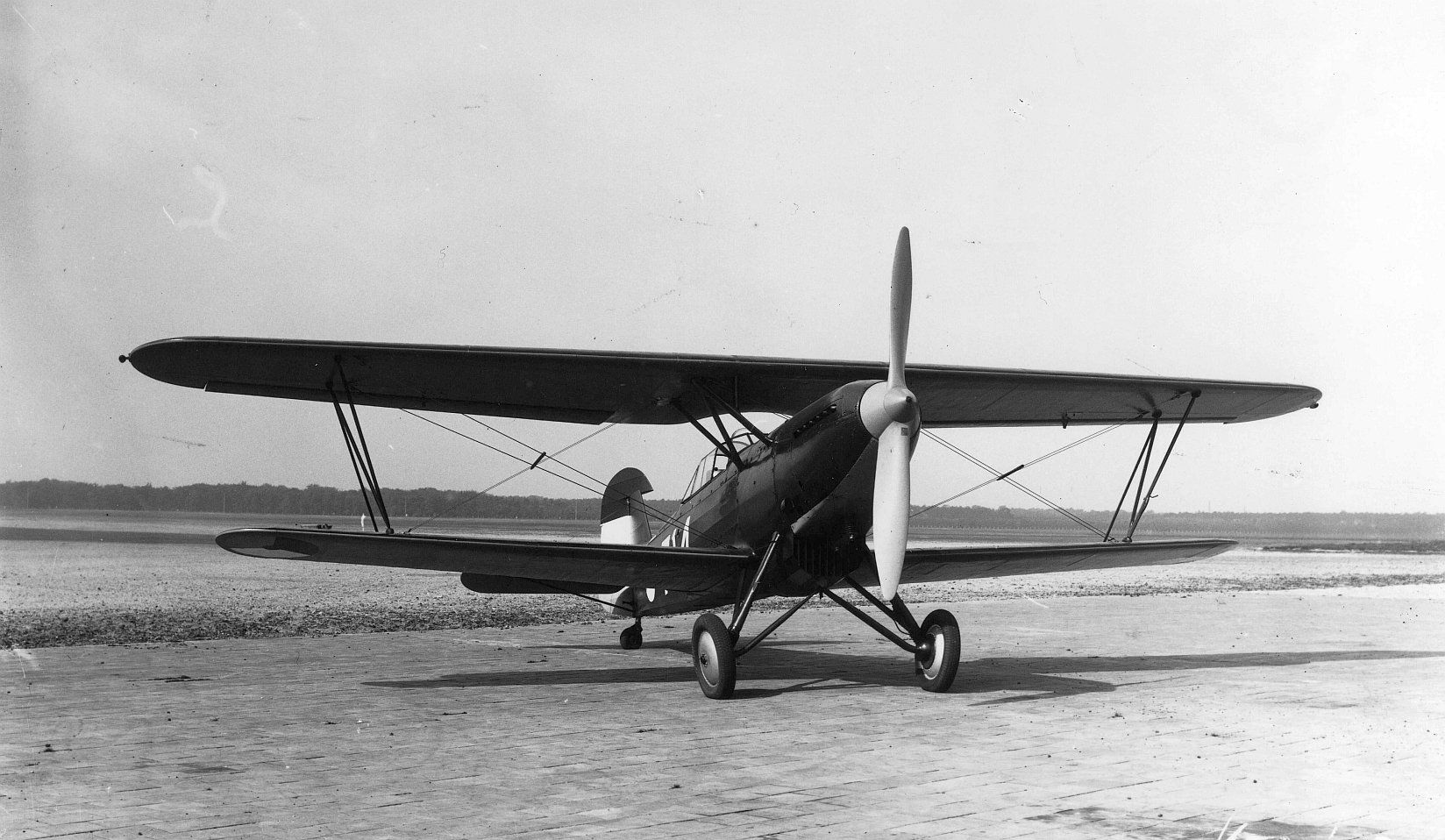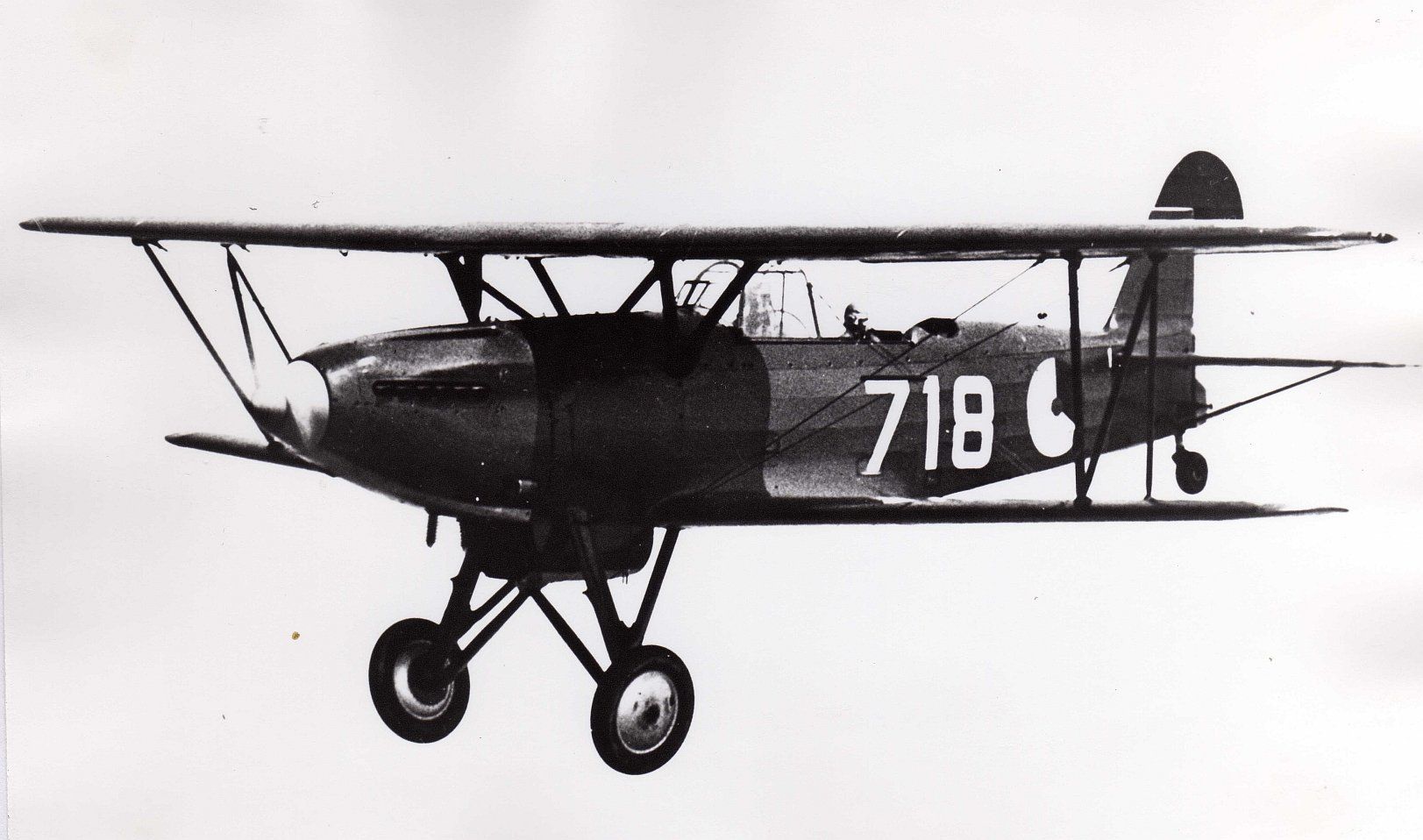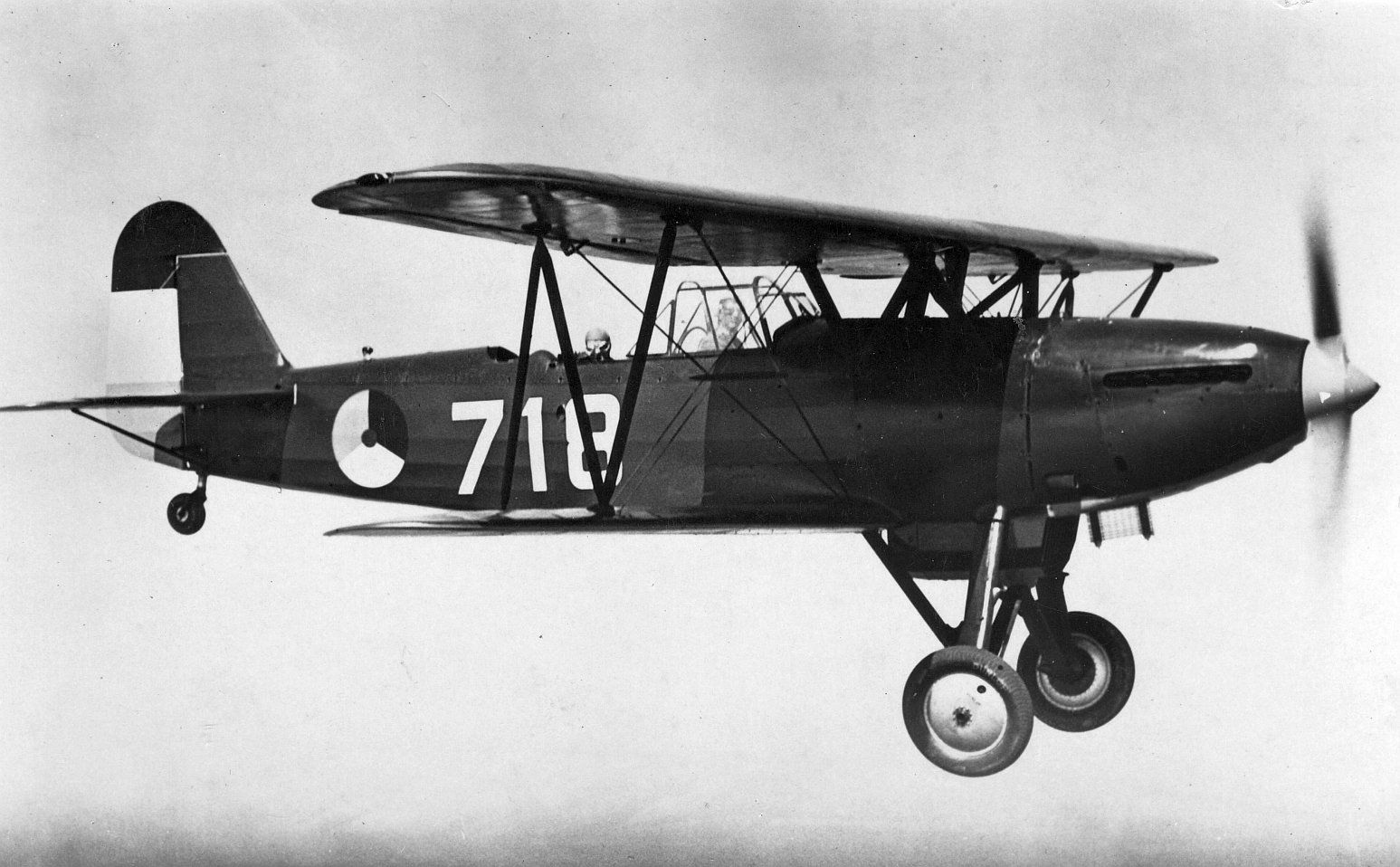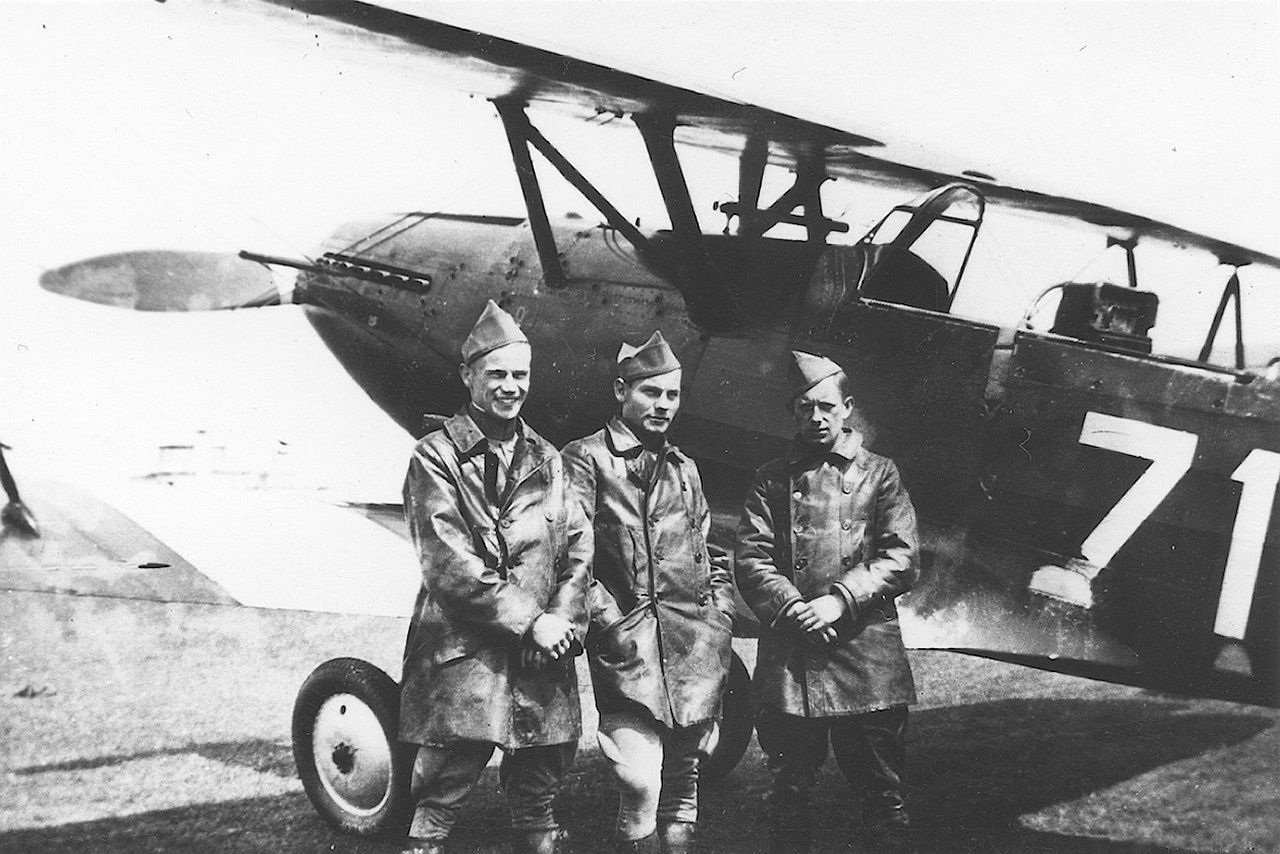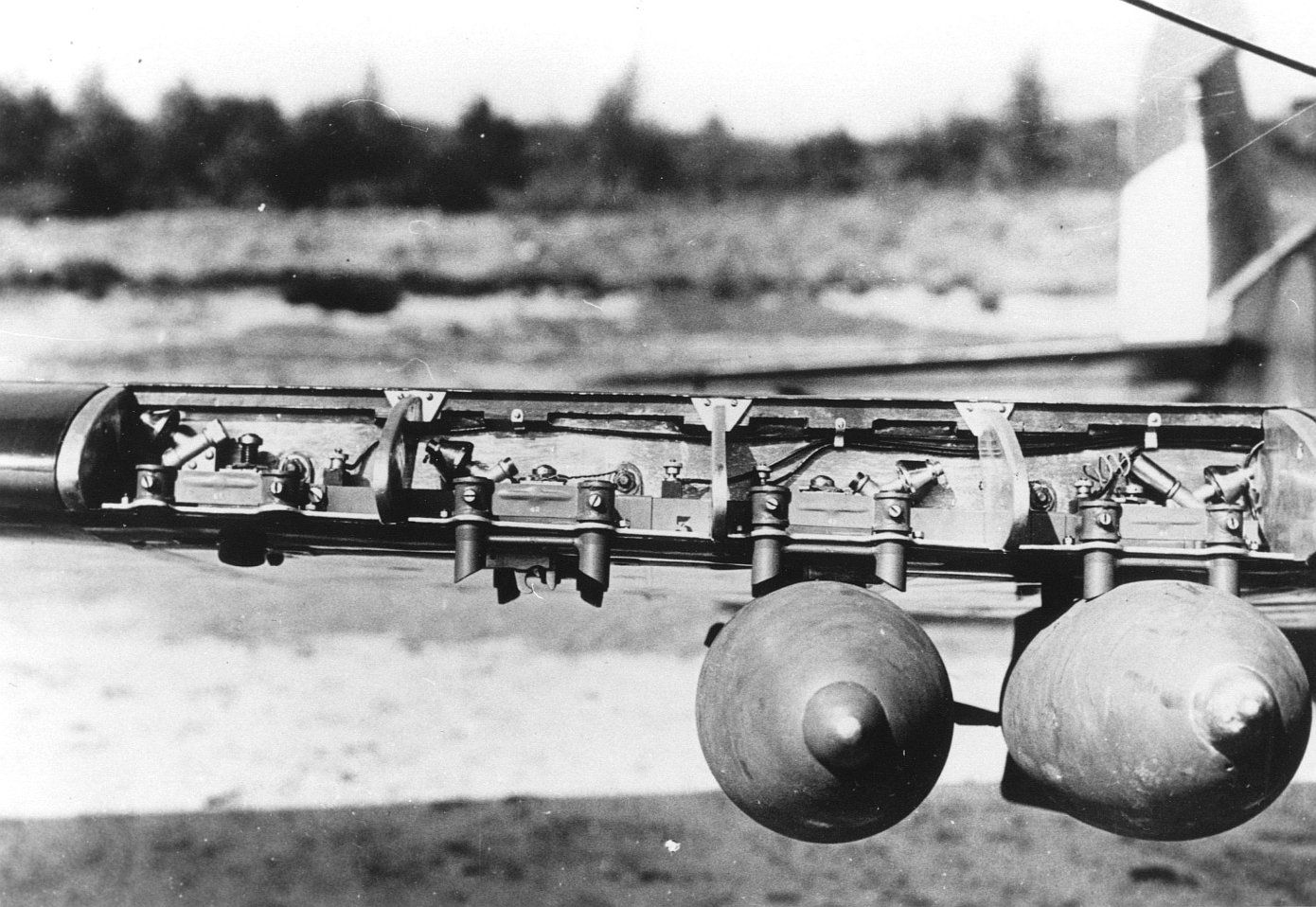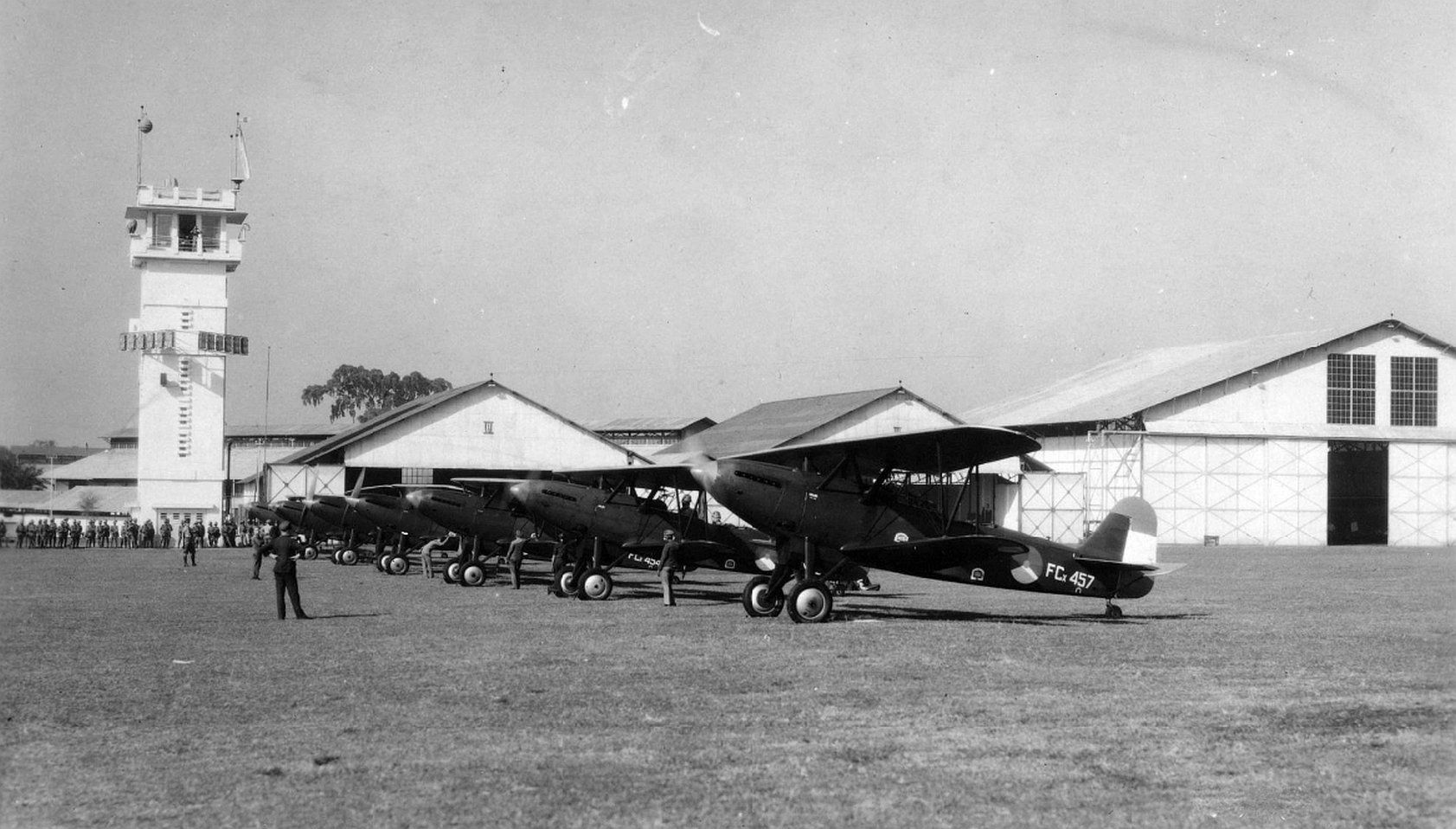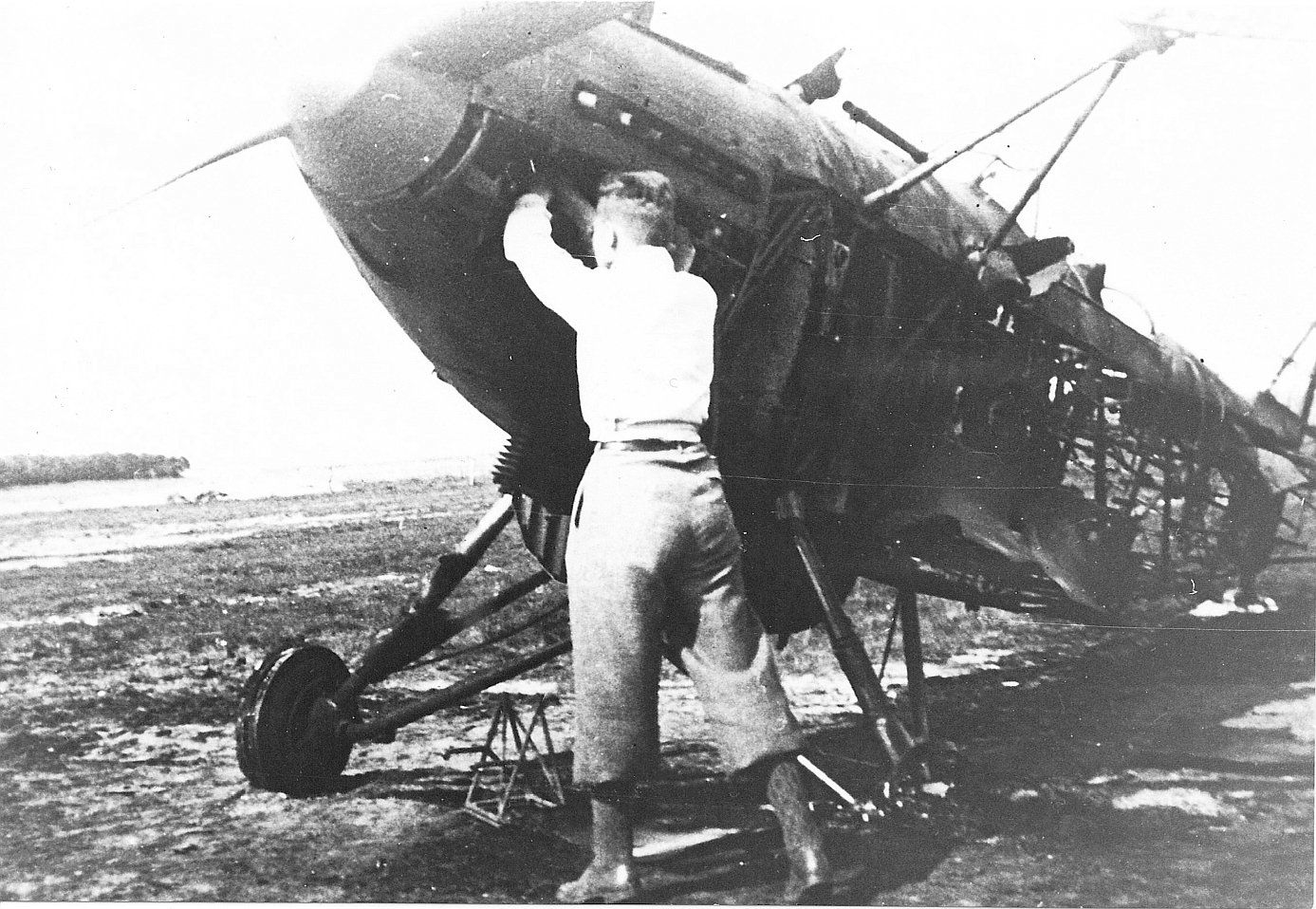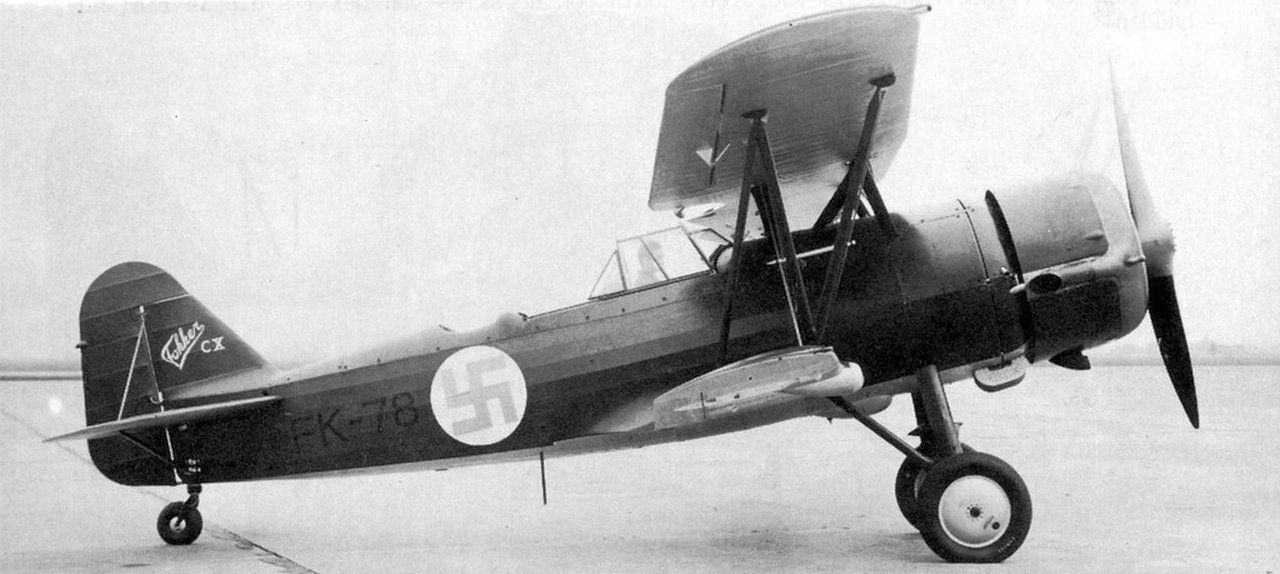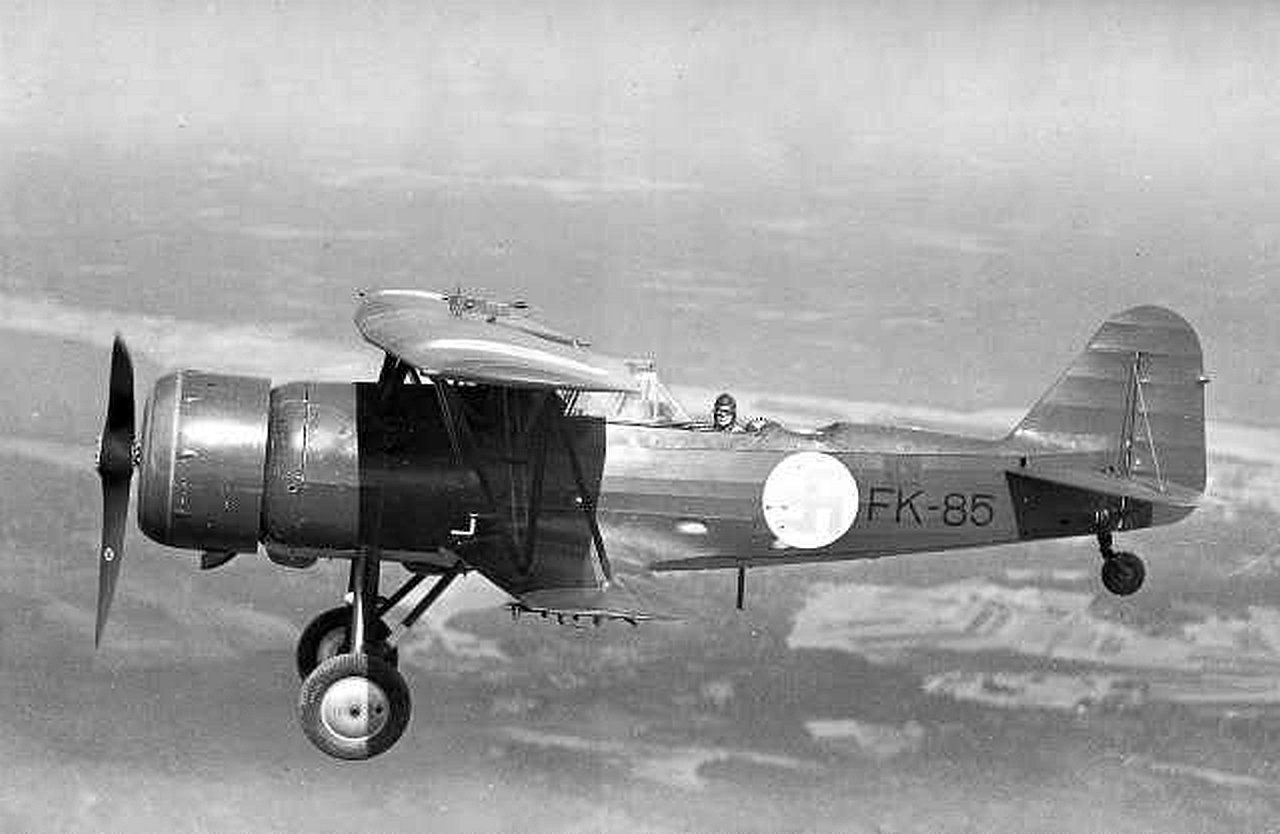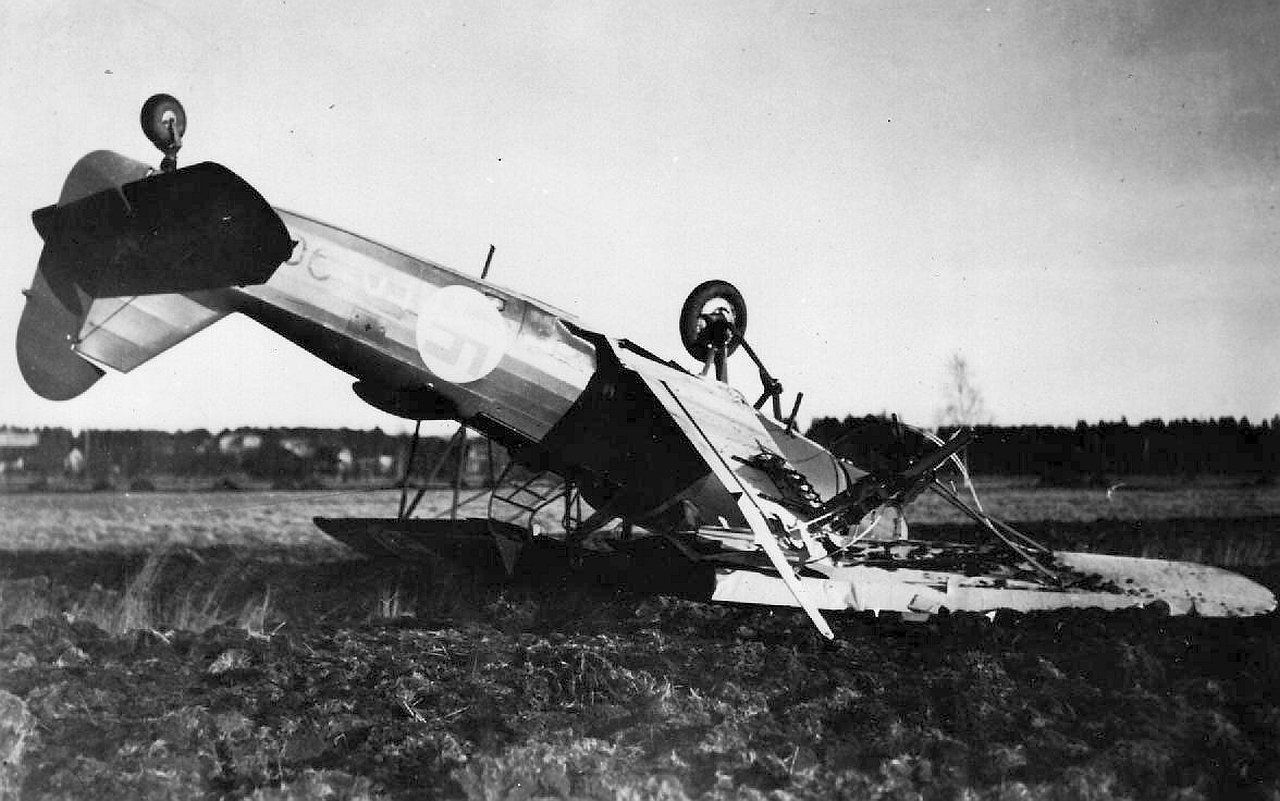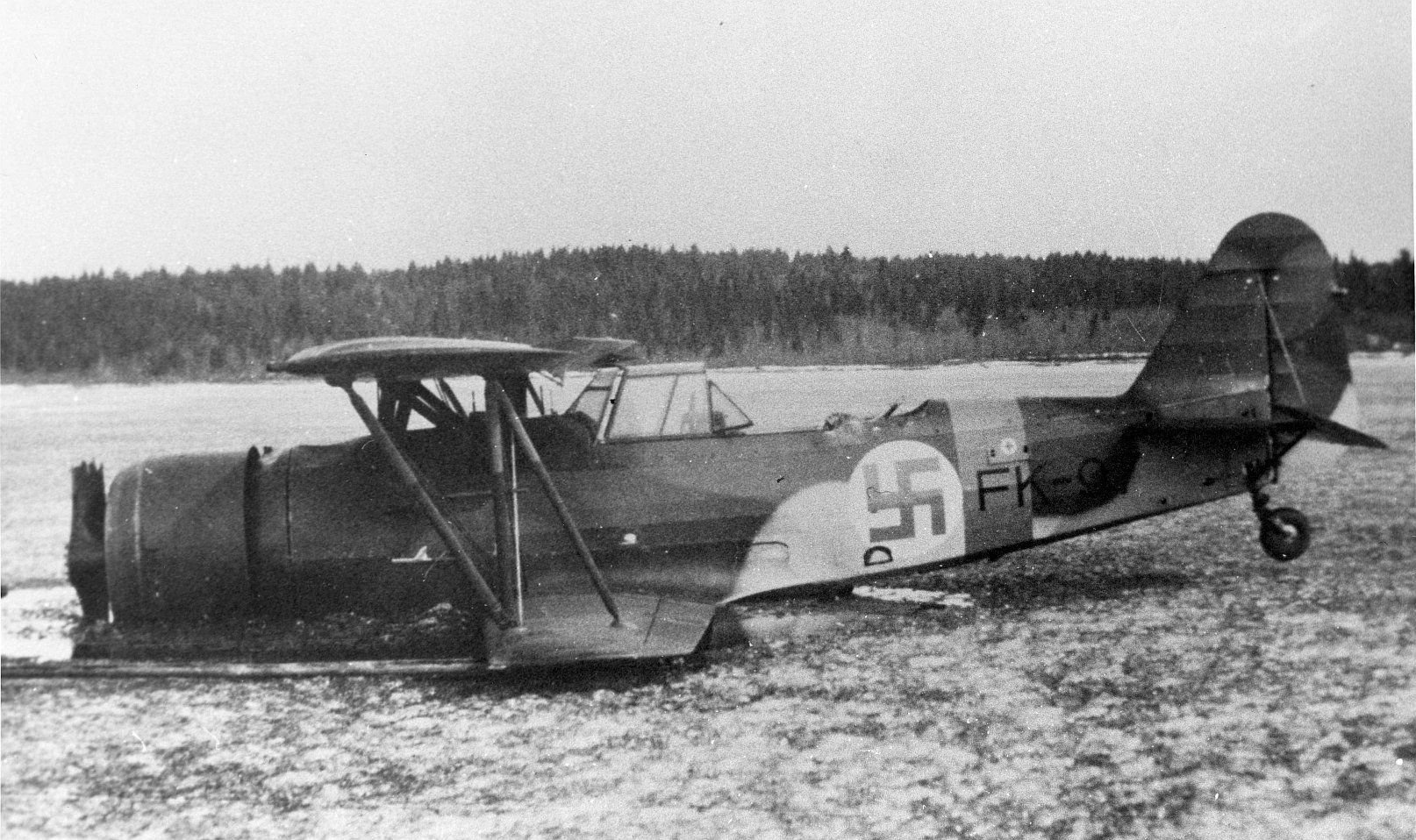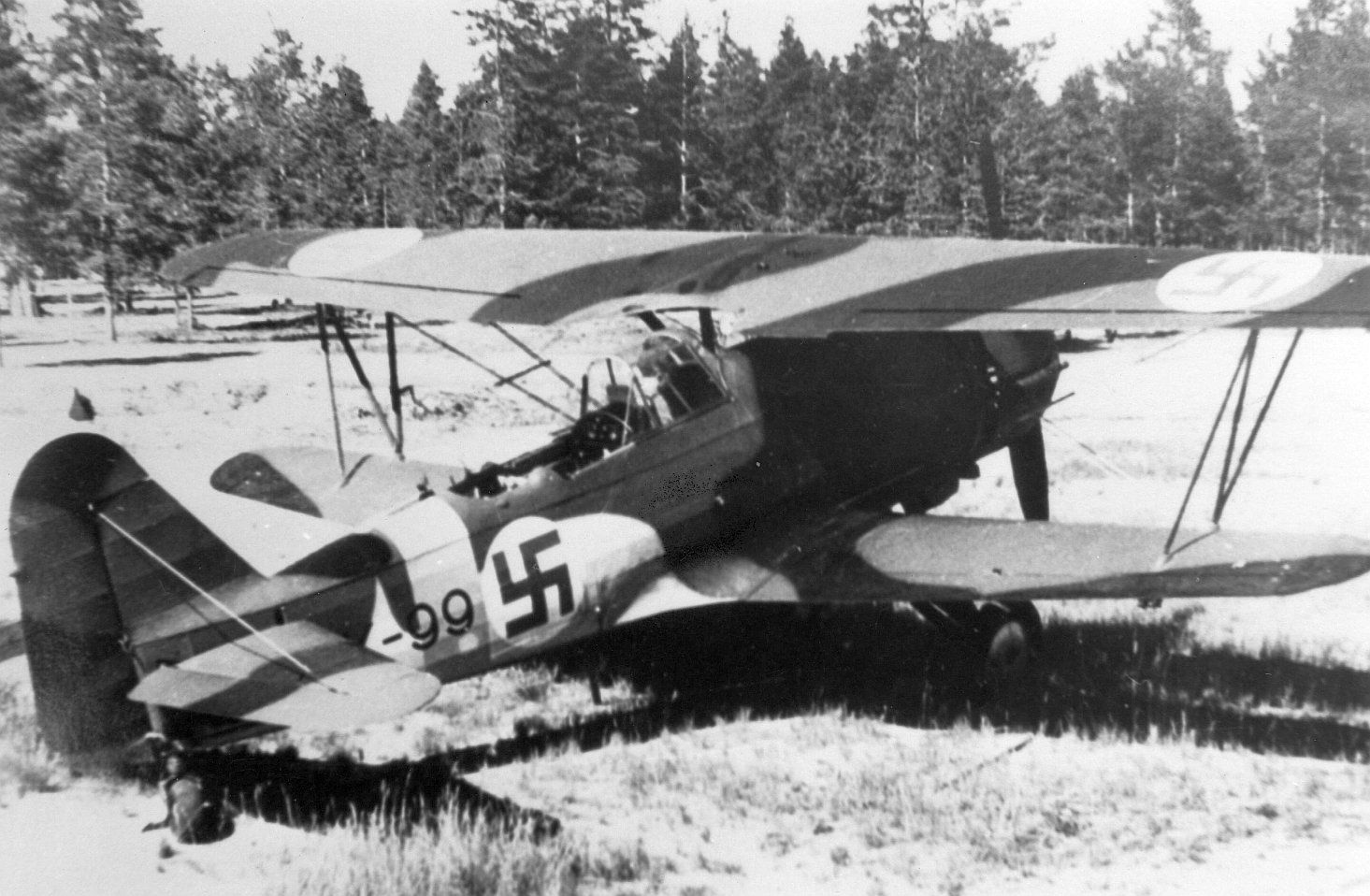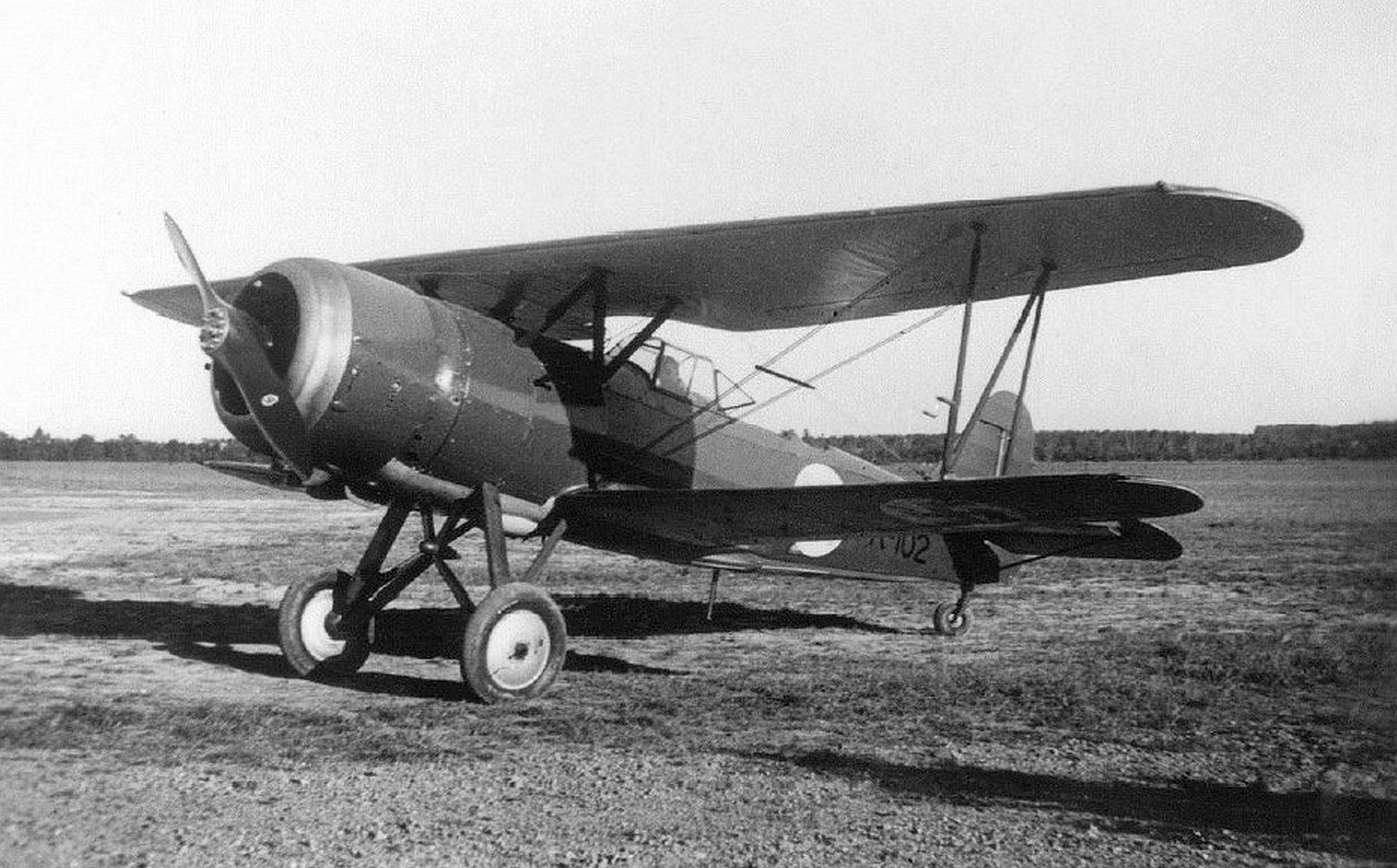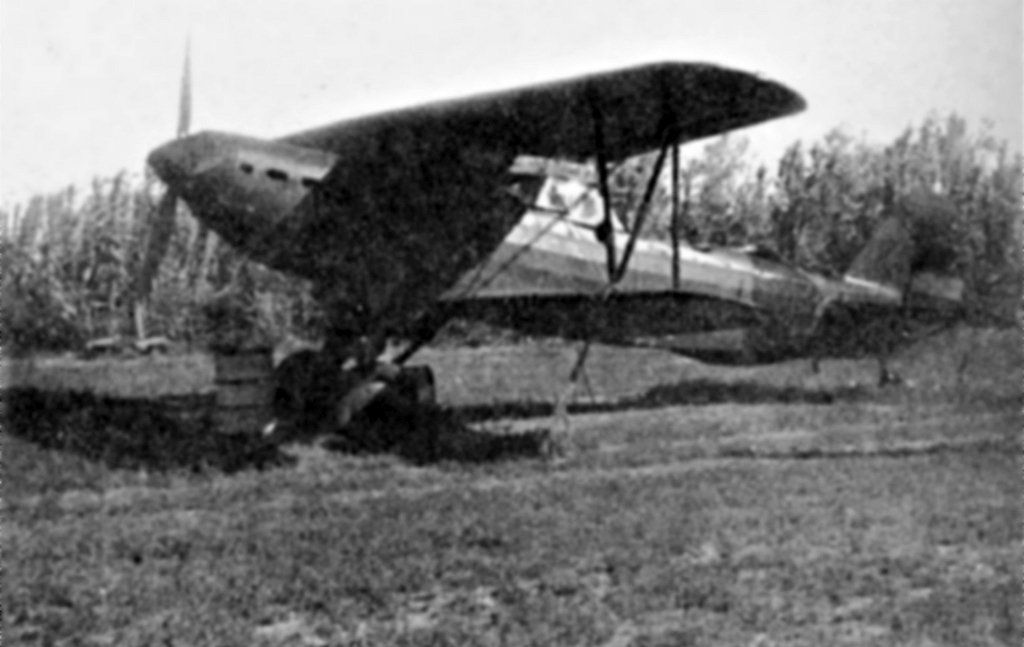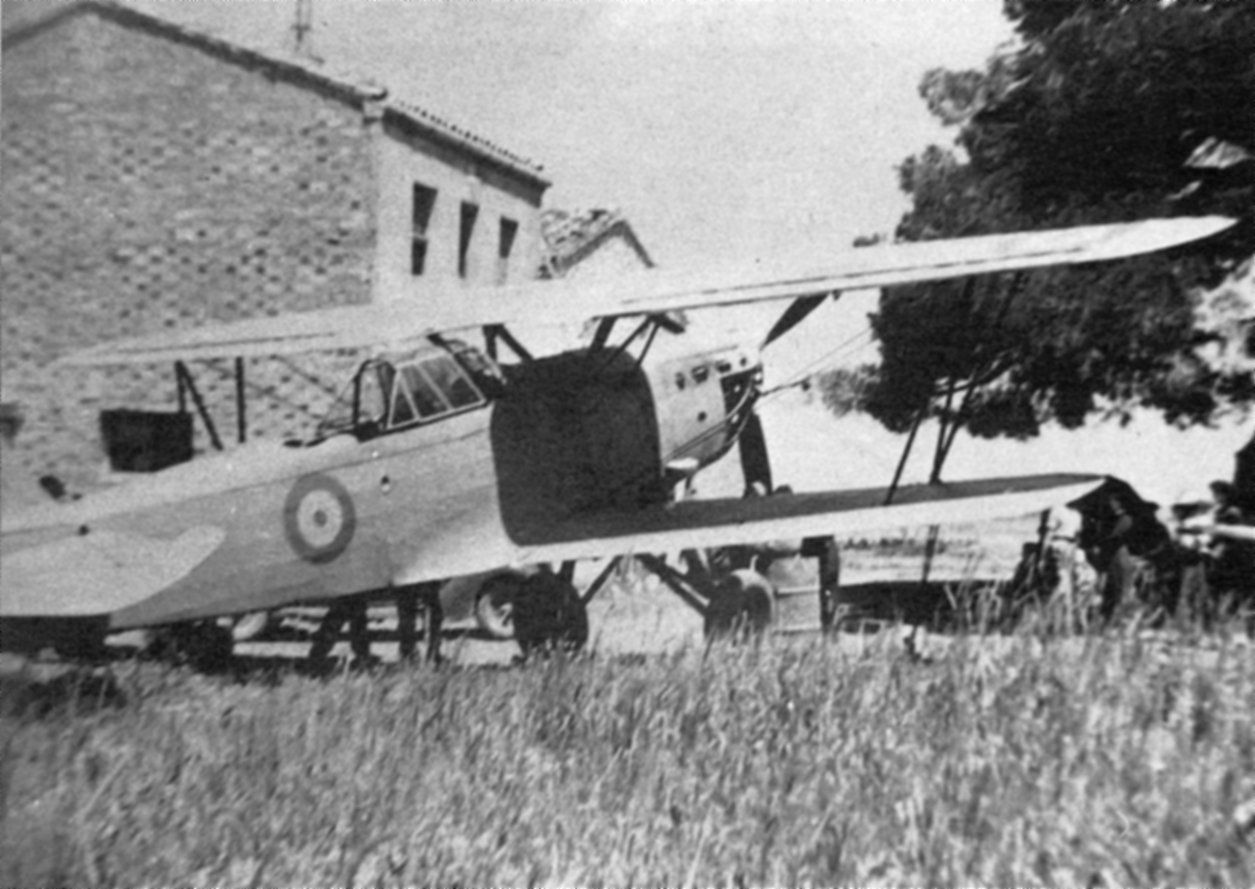Fokker C.X
The first prototype of the C.X appeared in 1934: a strategic scout plane, also equipped as a light bomber.
The C.X achieves speeds between 320 and 350 km / h and is equipped with quite a few improvements, such as a cockpit with a plexiglass hood. The engine is usually the 650 hp Rolls Royce Kestrel.
And the plane is able to carry a large amount of bombs under the lower wing.
In addition to the movable machine gun in the second cockpit, it has a front machine gun that shoots through the propeller circle.
With some aircraft there is even the possibility to shoot downwards through an opening in the floor of the second cockpit.
The LA-KNIL in the Dutch East Indies is the actual client, hence the Indian registration FCx 450 of the first prototype.
There, the CX will receive additional controls in the second cockpit for teaching purposes.
Still, this scout / light bomber continues to be too traditional in design.
The partly wooden wing, the single-engine biplane version and the fuselage finished with a tubular frame and mixed upholstery were almost (out)dated at that time.
During the episodes between 1934 and 1936, there is increasing competition from single-wing, twin-engine scout / light bombers. This made the aircraft in question faster, more agile and could carry more bombs.
Interesting is the important role in Finland during the two Finnish-Russian wars from 1939 onwards.
All in all, a total of 74 C.X aircraft are built, 35 in Amsterdam at Fokker 39 and in Finland 35 licensed.
The Dutch LVA takes 21, the LA-KNIL in the Dutch East Indies 14 and Finland directly from Fokker another 4.
It is a beautiful aircraft that will also cause many problems in maintenance and further use.
This was a major handicap during the May days of 1940. The C.X was often not usable or had to return with problems.
In particular in the Netherlands, but also in the Dutch East Indies, the shortage of accompanying fighters for the C.X has also been a major disadvantage.
Click on the photo to enlarge the photo
-
01
ButtonThis is part of the looping of the first C.X prototype in 1934.
Made by the Kap.Flyer B. Van Lent of the LA-KNIL, (Aviation Department Royal Dutch East Indies Army).
Van Lent and the Fokker pilot Emil Meinecke perform the first flight tests.
In that first period, the C.X does have the Dutch country designation, which is the same in the Dutch East Indies. A registration will only be added later.
-
02
ButtonPhoto at Schiphol, where the oil cooler is initially missing.
The tail shoe has been replaced by a normal tail wheel, as desired by the LA-KNIL.
Later the Dutch LVA will wish the tail shoes again.
The plexy glass cockpit hood also belongs to the version for the Dutch East Indies.
The first LVA planes will have them installed later.
Actually incomprehensible all those different cost-increasing versions in a time of economizing.
-
03
ButtonThe first prototype without registration, but with Dutch markings.
Here at Schiphol Airport during the trials by Kapt-Vlieger B. Van Lent.
He will eventually accept the C.X aircraft for the LA-KNIL.
Wingspan 12 m, length 8.8 m,
Height 3.3 m wing area 31.7 m ^ 2.
Plain weight 1450 kg Take off weight 2250-2350 kg
In the distance the Shell branch for the fuel supply.
-
04
ButtonThe same aircraft with the military hangars of the LVA at Schiphol in the background.
Initially, the CX gets 650 hp Hispano-Suiza engines.
Some other motorcycles will be added later.
The 650 hp Rolls Royce Kestrel.
The Bristol Pegasus of 835 hp
And a heavier Hispano Suiza of 860 and 925 hp.
-
05
ButtonThe first prototype. flown by Kapt-Vlieger B. Van Lent from the LA-KNIL Dutch East Indies.
The photo taken from another C.X, flown by Fokker pilot Emil Meinecke.
Here the performance of the C.X:
- Max. speed 320-355 km / h cruising speed 270-297 km / h
- Landing speed 94 km / h
- Flight range 830-903 km
- Ceiling 8800 meters.
Armament:
- 1 or 2 fixed machine guns and a movable 7.9 mm machine gun
- 400 kg bombs, 4 of 100 kg or 8 of 50 kg or 16 of 25 kg.
- Sometimes a 20 mm gun, shooting through the propeller shaft, also called moteur canon. (Mounted only on the 700,703, and 750 from LVA.)
-
06
ButtonThe same prototype for the first time with the Dutch East Indies registration FCx450.
Photo taken next to the concrete platform, close to the Shell location.
Left one of the new hangars from the early thirties (Hangar A).
Still without an oil cooler that sticks out, that will be added later.
-
07
ButtonThe FCx450, at rest here before going back into the air. The construction nr is 5379.
Most of the test flying takes place at Schiphol Airport near the Fokker location.
Presumably Kapt-Vlieger B. van Lent is in the first cockpit.
The company in the background may be VIP's.
-
08
ButtonThe same aircraft, now with the engine running.
The observer / gunner is standing or sits in a curious position here.
Perhaps he is standing, to have a better view of the surroundings.
There are reports that the ability to adjust the seat height is being tested.
The first flight takes place on October 9, 1934.
-
09
ButtonOn December 7, the FCx450 has to make an emergency landing near Hoorn, due to fog.
There, the C.X overturns and is partly above a ditch.
Pilot Emil Meinecke and observer F. Stok come out with great difficulty.
Stok can crawl out through the ditch, but Meinecke can only be freed by sawing a hole in the hull.
This is a dangerous operation as part of the fuel flows freely into the ditch.
It will be the first of quite a few major and minor accidents that continue to haunt the C.X.
-
10
ButtonIt is even clearer to see how the test pilot finally managed to get out.
And it is also clearly visible how big the damage will turn out to be.
-
11
ButtonAnother accident from the test period of the C.X
Pilot Kapt-Vlieger B. van Lent flies the FCx459 of the LA-KNIL.
An emergency landing follows on November 11, 1935 due to the complete breakdown of the propeller.
Place of action is near Sloterdijk, west of Amsterdam, then still rural and later a large district.
Van Lent came was not injured.
The c/n is 5388.
LA-KNIL buys the C.X as a replacement for the Fokker C.V, but will use it as a transition trainer for the larger aircraft.
This means that a second instrument panel must be fitted.
All this takes place at the LA Aviation Department at Kalidjati Airport near Bandoeng.
-
12
ButtonBack to the prototype FCx450.
After the rather serious accident with a lot of damage, the plane is transported back to the factory in Amsterdam-Noord.
Here you see the result of the massive recovery operation.
Without visible residual damage, this C.X will go with the deliveries to the Dutch East Indies.
Later there will be a discussion whether this 450 in the Dutch East Indies is the restored or a new one.
The construction numbers are 5379 to 5392.
The registrations run from FCx450 to FCx463 and the delivery period runs from 1935 to 1936.
-
13
ButtonThe second prototype of the C.X receives the civil Fokker registration PH-AKIJ.
Civil registration avoids problems flying over countries that may have a problem with a military aircraft flying overhead.
It is c / n 5380 ultimately intended for the LVA Aviation Department in the Netherlands as the 700.
This C.X made its maiden flight on May 16, 1935.
The engine used is a 585 hp Rolls Royce.
The cockpit already has a plexiglass cover.
Given the white overalls, First Lnt-Flyer G. Sandberg of Fokker and LVA is in the first cockpit.
-
14
ButtonNice photo in preparation for a test flight of the PH-AKIJ.
Kap-Vlieger B. van Lent from LA-KNIL is in the first cockpit.
Sandberg leans forward on the stairs.
He is wearing his white overalls, with parachute and oxygenation.
Typical is the way of covering his head.
On the right, the motor is turned on with a hand crank.
-
15
ButtonAnother nice action shot flying low over a Hangar A at Schiphol.
A Douglas DC-2 from KLM awaits resigned or full of admiration.
-
16
ButtonOn August 26, PH-AKIJ makes its ninth flight.
A day later, the pilots B. van Lent depart from LA-KNIL and First Lnt-pilot Jhr. Mr. G. Sandberg from Fokker for demonstrations to Ankara Turkey.
On September 5, 1935 during a vertical dive, both wings break off and Sandberg has no chance to open his parachute in time.
He loses his life and aviation-loving Netherlands mourns the death of this great pilot.
Oh irony the mortal remains are flown to Amsterdam by a Lufthansa Ju 52.
That could of course have been KLM too.
-
17
ButtonWing construction on the Papaverweg in Amsterdam North.
This must have been around 1935, considering the clothing.
It is also striking that the factory halls are no longer crowded, there is much more space and light.
But wood is still the basic material for those wings.
And perhaps also fewer employees.
Order and cleanliness also radiates from it.
-
18
Joop Carley (Dutch text)Due to all the complications with the first and second prototype, there is even a third prototype of the C.X.
The c / n is 5418 and bears the name Fokker C.X and Hispano and only later that X-1 designation.
The propeller is three-bladed, an oil cooler is added before the air cooler.
On March 31, 1937, the X-1 comes with a 925 hp Hispano-Suiza engine for testing at the LVA.
The propeller shaft provides an opening for a 20 mm gun. Also called moteur canon.
The firing rate is 400 bullets per minute.
The synchronized machine gun is added to that.
On the right side of this photo is the rear section of the PH-AFI, a KLM cargo plane (The Jumbo).
It is a one off plane built at Werkspoor designed by Joop Carley.
-
19
ButtonHere the silver-colored X-1 still without an indication.
-
20
ButtonThis X-1 is on a Scandinavian aviation exhibition.
This CX must also have been temporarily registered as PH-ALX.
A Danish description on the board behind the C.X, translated into Dutch:
FOKKER C.10
Hispanic Switzerland 12 YCRS
Side view of reconnaissance and combat aircraft and light bomber.
Which certainly helped, because Finland is creating an interesting relationship.
It will lead to a delivery of 4 aircraft in 1937 and a licensing contract.
That is why 35 C.X aircraft are built under license in Tampere.
A total of 39 Finnish aircraft.
-
21
ButtonAnother nice shot of that third prototype of the C.X
Equipped with a very strong 860 or 925 hp Hispano Suiza 12 YCRS engine.
Speed 350 km / h flight range 1000 km.
Compare this to the other C.X aircraft, the speed being 320 km / h and the flight range 800 km.
It is curious that already around August 2, 1933 there is talk of the arrival of this version.
From November 4, 1936 to March 31, 1937, registration is under the civil registration PH-ALX.
However, the X-1 registration is used as a demonstration, test and exhibition device.
This c / n 5418 is still on sale at LVA from April 1937.
The LVA license plates are actually used for this and 750 as registration.
After all, a certain logic from the 700 series from LVA.
-
22
ButtonX-1 c / n 5418 was deregistered from the Civil Aviation Registry on March 31, 1937.
As 750 and with the LVA features and while maintaining the light gray color, the status is somewhat vague
The C.X flies quite a bit for Fokker and is also active in the LVA environment.
But this special version with its 925 hp Hispano 12 YCRS engine and motor canon has been taken out of the picture at LVA.
Interestingly, the engine designation does not mention the name Suiza.
This and the next photo probably show the 750 on the Fokker grounds at Schiphol.
A somewhat curious story follows because of the Spanish Civil War.
-
23
ButtonDuring the Spanish Civil War from July 1936 to April 1939, interest in the C.X arose
The Republicans want to build the C.X under license.
To this end, the ex 750 may have come back to Spain with civil registration.
As an example aircraft for 14 aircraft to be built.
Even registrations LF-1 to LF-14 have already been established
It doesn't get any further than the ex 750 and a license-built C.X.
The Nationalists are said to have finished part of it as R-7 at the Ejercito del Aire.
Furthermore, unfortunately we are currently missing information.
-
24
ButtonThe Rolls Royce Kerstel engine of 650 hp is placed in both the Dutch and the Dutch East Indies delivery.
The water cooler is clearly visible at the bottom. The oil cooler will be placed in front of it later.
On the right is part of the fuel tank between the engine and the instrument panel in the cockpit.
-
25
ButtonProduction of the Hulls for the C.X on the Papaverweg in Amsterdam North between 1934 and 1935.
Here the welding work is clearly visible to a mechanic with welding goggles and the gas bottles present.
It seems that a smaller space is used for this.
Larger hulls are welded in the back.
-
26
ButtonThe first CX, with registration 700, delivered to LVA Aviation Department, appeared in 1934.
After the major accident in Ankara Turkey in September 1934 with the PH-AKIJ, the 700-701-702 and 703 return to Fokker.
They were not delivered for the second time until 1936.
Incidentally with c / n 5382, according to LVA and according to Fokker incorrect.
It must have something to do with those accidents.
Here a shot at Schiphol airport with tail shoe and open cockpit.
That will change later and look more like the LA-KNIL devices.
On the right the Shell station and on the left one of the large KLM hangars.
-
27
ButtonAfter the redelivery of the 700-701-702-703 in 1936 to the LVA (Dutch Air Force), the 700 of LVA suffers an accident.
Under the supervision of Fokker, the LVA rebuilds c / n 5382.
A new hull, a new engine, a half-plexiglass cockpit roof and a tail wheel.
The 650 hp Hispano Suiza engine is replaced by the 650 hp Rolls Royce engine.
And with that, LVA's CX devices increasingly resemble LA-KNIL scouts.
In this photo too, the 700 is close to the Schiphol platform.
-
28
ButtonThe 700 on a field diagonally behind one of the Schiphol hangars.
This recording was made before March 1937.
Also pay attention to the still missing oil cooler and the side lighting on the tailplane, which disappears after recovery.
-
29
ButtonThe 700 after mid-1939 in the orange mobilization colors.
This photo is from April 1939.
Apparently there have been problems with the 700 at Bergen Airport (NH)
It was only deployed from Bergen on 13 May 1940 at a quarter to 4 in the morning.
The mission goes to Wageningen via Doorn to support the Grebbe Line.
There, four CX aircraft are bombing.
On May 14, 1940 at 9 o'clock in the morning, the 700 starts from Bergen.
At 12.15 pm the 700 flies via Schiphol and Ruigenhoek, the reserve airport at Noordwijkerhout.
The Germans advance further and the 700 diverts to the south via Souburg (Vlissingen).
Together with a group of training aircraft they fly to Calais in France.
May 15 in Cherbourg and May 22 in Caen Normandy.
There the 700 is transferred to the French.
-
30
ButtonAnother photo of LVA's CX 700 at Schiphol Airport, shortly after the second delivery in 1936.
The plexiglass cover will be mounted later.
In 1937 the 700 was destroyed again. Nevertheless, the 700 participates in combat operations from the new Bergen airport, but from 13 May 1940.
It will not be the first time that there is often something wrong with the CX
Usually the CX is equipped with 8 50 kg bombs, 16 25 kg bombs or four 100 kg bombs.
With bomb racks mounted under the lower wing.
There are no extra tanks in that wing, such as with the C.IX.
This prevents the great danger of burning the extra tanks
Thus, even severely damaged CX aircraft return safely after a mission.
-
31
ButtonThe 701 in action here. The CN is 5383.
On May 10, after a major conversion period, the aircraft was almost ready in Amsterdam North.
An important point is the installation of a double controller.
It seems that this procedure is also identical to the LA-KNIL version.
The 701 did not participate in the defense of the Netherlands and fell into German hands on May 15, 1940.
-
32
ButtonAnother 701 of the Aviation Department parked at the Fokker terminal at Schiphol Airport.
From Amsterdam North, the aircraft are largely brought to Schiphol by flat boat.
The end line is actually a hangar, built south of the further airport complex. Later more Fokker hangars were built.
Schiphol consists of other hangars, a station building with restaurant, a hotel and a freight shed.
To the north there is also a military complex with six hangars for a while.
-
33
ButtonHard to read but probably another 700 from the LVA
c / n 5382 with 8 bomb racks.
The red, white and blue cockade cannot be seen here.
They may have to be added, given the many repairs to this device.
Nowhere is the orange triangle clearly visible and the tail is also missing red-white-blue.
And this scout / light bomber will eventually finish at Caen in Normandy France.
Or is there still a sequel to Spain, which has something with the CX
-
34
ButtonAn AIR DEFENSE manifestation on perhaps Ypenburg.
Somewhere around 1936 - 1937.
The balloon bears the Dutch registration PH-AHE.
A squadron of three CX aircraft from LVA blows a tone with it.
It must have been fun ....
-
35
ButtonCn 5384, the 702 delivered in the group 700, 701, 702 and 703, ordered in 1934.
The 702 would therefore have been under repair at Fokker in Amsterdam-Noord.
And this device must also have fallen into German hands.
Incidentally, here are things such as the oil cooler, but also the full machine armament at the front and rear.
Also very visible is the full bomb load, which also hangs under the lower wing.
In this previous photo, the extra machine gun for shooting down was temporarily mounted.
Interesting, but not much used and eventually removed.
The position on the floor of the second cockpit has not been particularly comfortable for the gunner.
-
36
ButtonThe 702 from LVA Aviation Department with already running engine.
It looks like this device is already equipped with a double control.
This makes it suitable for flying as a training aircraft.
A rear wheel is also fitted instead of a tail shoe.
But a plexiglass cover is not yet on the cockpit.
The 702 must also have been in Amsterdam North in May 1940.
The renovation is not yet complete when the Germans invade the Netherlands.
The device is therefore advanced and presumably destroyed.
-
37
ButtonIn the run-up to the mobilization of the Dutch army in 1939, the LVA is given more scope.
That is why a brand new airport is being built at Bergen NH.
It will contain four hangars, staff quarters and a large concrete platform.
Furthermore, some smaller sheds and around it small, concealed sheds for the Fokker CX
Here a front view of the 704 from LVA, made around 1936.
Cn 5400 or 5402 made the first flight in February 1936.
This CX already has a plexiglass cover.
The 704 is at the German invasion on 10 May 1940 in hangar 4 on Bergen and is bombed there and burnt out.
-
38
ButtonIn the end line of Fokker at Schiphol, a whole group of CX aircraft is already equipped with a tail wheel.
All these devices are also equipped with a plexiglass cover.
Fairly visible from front to back: the 707-706-710-711-713-712-715 and 716.
At the end of a subsequent delivery to Denmark: the CV E registered R-21.
-
39
ButtonThe 707 of LVA near Bergen NH, late 1939 or early 1940.
After all, the device is already equipped with orange triangles and tailplane.
Flown by 2nd Lt.vl. J. de Laat and 1st Lt from left to right G. Jansen.
During the German invasion in 1940, the 707 was overhauled in a hangar at Bergen airport.
The Luftwaffe bombs the airport on May 10 and the 707 is completely destroyed.
This happened because the aircraft was not in the camouflaged sheds but in one of the larger hangars.
Something awkward also happened with the GI aircraft that were later stationed there.
They are all neatly parked on the platform on the first day of the war.
The Luftwaffe really knew what to do with that!
-
40
ButtonBeautiful formation flight around 1935-1936 from the 710-714 and 705.
With the rear plane the 705 quite a lot happens during the German invasion on May 10, 1940.
It will be the command plane of Ritmeester Vlieger J. Hoytema van Konijnenburg.
There is an order to attack Waalhaven Airport on May 10, 1940, along with five other CX aircraft. There are many German aircraft there.
The 705 does not start and is left behind in Bergen.
Then there is an order to attack the Germans at Moerdijk and now the rear machine gun refuses.
On May 12, the 705 starts again at 4 pm with 8 50 kg bombs again to Waalhaven airport where German aircraft are located.
Now 3 bombs remain stuck under the wing.
On May 13 at 3.40 am with commander R. Hofstede the forest edge of Wageningen is attacked.
At 11.22 am with 2nd Lnt. vl. S. Postma on the way to Grebbe and Wageningen together with 3 CX s.
The 705 is severely damaged.
On May 14 via Schiphol to Ruigenhoek. With a further flight ban.
Of course with 1st Lt.vl. E Hoekstra and Kap wrn C.van Marcelis left for Zoutelande Zeeland and landed at 9 p.m.
On May 15 to Boulogne, Bray Dunes and Dunkirk where the 705 will be left. The pilot returns to the Netherlands, the observer moves to England.
-
41
ButtonArrangement of three CX aircraft, including extra board lighting behind the second cockpit.
Presumably at the new Bergen NH airport, sometime between 1937 and 1939.
Above 704, mid 708. The right-hand aircraft is not legible.
-
42
ButtonThe 708, cn 5404. First flight on March 6, 1936.
Stationed at Bergen NH
Departs May 10, 1940 at 11 a.m. to bomb Waalhaven Rotterdam where German aircraft are already located.
Waalhaven also remains in German hands.
Crew 2nd Lt-fl S. Postma and 1st Lt-wnr. H. Landman. pilot and gunner respectively.
The emergency landing due to lack of fuel is discussed in the next photo.
-
43
ButtonInteresting photo of the 708, already in the orange mobilization colors.
On the way back from Waalhaven airport on May 10, 1940 attacked by Me-109 aircraft.
The 708 makes an emergency landing in Den Hoorn near Delft.
The device is only slightly damaged or had a lack of fuel, but apparently has not reacted, although that is very uncertain.
This shot shows damage on the rear section, hull and rudder.
Before (see the puttees) a Dutch soldier, perhaps an aviator or observer?
What is strange that the conscious soldier is not wearing a helmet or leather jacket.
-
44
ButtonEven quieter times, the first and Indian prototype the FCx450 during an ordeal at Schiphol.
Recording from 1934 with one of KLM's three F.XXII aircraft faintly in the background.
Flyers are Emil Meinecke and Kap.Vl. B. Van Lent of LA-KNIL.
-
45
ButtonThe 709 c / n 5405 was delivered on 20-03-1936 and is stationed at Bergen NH airport.
The 709 is still here in the period 1937- 1939 and therefore without an oil cooler and without a Plexiglas cover.
The 709 group also departs from Bergen to Waalhaven Airport on 11 May 1940 at 11 am.
German Me-109 aircraft go off on the commando plane after the bombing.
Aviator and squadron commander is 1st Lt.vl. J. Pleij and the gunner is 2nd Lt.wnr is M. Tjak.
20 hits are collected and one ends with an emergency landing near Wateringen.
What else happened to the 709 is unknown.
-
46
ButtonThe 708 of the LVA also in more peaceful days c / n 5404.
In 1937 at the AVIA exhibition in the Houtrust halls in The Hague.
Nicely polished with the plexiglass cockpit hood.
To the right of it a recommendation LEARNS FLIES.
With a Pander of Koolhoven.
In the back Bata Schoenen advertises in Best with its finest lightweight flying shoes.
In the back left is an openwork CX with the light fuel tank and the engine clearly visible.
Who could have guessed that it would all be over with the 708 on May 10, 1940.
She started World War II on May 10, 1940 with the first mission of the Air Defense Command:
"BOMBARDEER without delay the German planes in the fields Waalhaven and Valkenburg".
Within the Bergen section, further actions will follow at the Moerdijk bridges, the Feijenoord stadium and the Grebbeberg.
There is still a lot of bombing and shooting, but the crew losses may also be there.
Losing more than 40% is therefore not acceptable to the Air Defense Command.
People quickly switch to the HUBOBE system house tree sapling.
That is flying very low and if possible through the trees.
The Strategic Reconnaissance Aircraft Division in Bergen ceases to exist on May 14, 1940.
-
47
ButtonThe 710 of LVA Aviation Department in hangar nr 4 at Bergen Airport, cn 5406, after the German bombing on May 10, 1940.
The first flight is made on March 20, 1936.
In 1939 he is repainted with the orange triangle and the orange rudder because of the mobilization.
In itself, this 710 is still quite off.
Two other CX devices that are inside appear to be completely irreparable.
The Plexiglas cover is still completely intact underneath.
Sad what is left of these relatively new hangars and the beautiful airport.
Incidentally, at the Fokker GI we treat the fate of a very large group of GI yacht cruisers who are simply outside in line on 10 May 1940.
That is even sadder in every way.
-
48
ButtonPhoto taken around 1938 of an arrangement of 8 CX scouts of the LVA.
At the front is the 715, the others are difficult to read.
The image was taken from the side of Bergen NH airport
-
49
ButtonPhotographed from the third aircraft: the 705 and 709 above Ypenburg airport near The Hague.
Apparently the name had to be clearly on the grass.
You assume that that name disappeared in May 1940.
That 709 has another special task: it becomes a command plane.
The squadron commander 1 st Lt.vl. J. Pleij will receive a bomb aimer on top of the hull.
That bomb aimer was not found in the other CX scouts.
But the 709 apparently never got a plexy glass cover.
This is how Jan splinter comes through the winter.
-
50
ButtonLVA's 709 ready to go and lots of fun.
With a shower to keep the platform of Bergen clean.
Maybe that bomb aimer has something to do with that unplaced hood.
-
51
ButtonAs a follow-up to photo 50, five CX scouts with the 713 of LVA on the far left.
In drizzly weather at the brand new Bergen NH airport.
Ready for departure for an exercise with engines already running.
Most with a half-open hood.
-
52
ButtonThe 712th of the Aviation Division (Air Force) around 1936, flying in formation.
All in all an elegant device, unfortunately in terms of development what fell behind.
The bomb aimer used by the group leader when bombing is clearly visible.
The bomb suspension points are just visible under the lower wing.
The engine cooling and oil cooler are also clearly visible.
The cockpit hood is still missing.
In the May days of 1940, the 712 ends at the emergency airfield Ruigenhoek near Noordwijkerhout.
Burned or destroyed on May 14, 1940.
-
53
ButtonThe 710 of LVA in foggy weather near Bergen Airport.
-
54
ButtonThe 714 probably also in the Bergen area.
This aircraft also came to an end on emergency airfield Ruigenhoek on 14 May 1940.
-
55
ButtonThe CX 711 and behind it the 718, probably at Bergen airport.
The impression exists that both are stripped of rosette and red white blue.
Then these two are brought to the hangar to be painted in an orange triangle with a black border.
And will this picture date from the mobilization period 1939,
The 711 (cn 5407) was delivered in March 1936 and immediately belongs to the permanent Bergen group.
Or as it is officially called: "The Strategic Reconnaissance Aircraft Division in Bergen".
Flown by 1e Lt-vl J. Vermeulen and res. 2nd Lt.wnr.H. Van der Heijden.
The 711 receives a substantial amount of work during the German invasion from May 10, 1940.
All this is accompanied by a mountain of technical defects.
The 718, delivered in May 1936, is stationed at Hilversum Airport.
The aircraft was not ready for combat on May 10, 1940 and is heavily damaged.
-
56
ButtonThe 711 already in the orange war painting.
Photo taken late 1939.
On May 10, 1940 at 11 a.m., deployed from Bergen to the Waalhaven Rotterdam airport and returned to Bergen.
Back in the air at 4:40 PM and back again.
At 5.15 pm again in the air, now flown by 2nd Lt. Vl. H. Asjes.
The aircraft goes with 3 other CX aircraft to German positions at the Moerdijk.
The 711 eventually flies alone to the target. Of the 8 bombs, two remained under the wing.
Then May 12 again to Waalhaven where another bomb remained.
On May 13 at 3.47 (!) To a forest edge near Wageningen dropped bombs and fired a lot of machine gun.
In action again at Wageningen on May 13 at 11.22 am repeated again.
On May 14 at 9 a.m. as a command plane with Lt.vl. J. Vermeulen and after FIVE war missions via Schiphol to Emergency airfield Ruigenhoek.
And set on fire there by own soldiers.
-
57
ButtonA combat patrol in 1939 consisting of the 713, the 708 and the 715. The fourth is unknown.
What is known is that as of May 10, two escadrilles of the group are merged into one as a result of many bad luck and defects.
The 713 cn 5409 made its first flight on April 2, 1936.
On May 10, 1940 at 10.40 first started with 1 st Lt. Vl. R. Hofstede with two other CX scouts on the way to Valkenburg Airport near Katwijk.
Together they drop 21 50 kg bombs. Three Junkers Ju 52 aircraft are hit. On the way back to the beach, five more Junkers are eliminated.
At 4.40 pm on their way to German reinforcements at the Feijenoord Stadium and the Moerdijk, together with 3 other CX aircraft, they drop 22 50 kg bombs.
On May 13, 1940, a failed start attempt. Then, at 11.22 am, still to Wageningen where, together with others, 32 bombs are dropped.
Finally, many moving targets are heavily machine-gunned.
On May 14, 1940, the plane goes to Ruigenhoek and is set on fire there.
All in all four exceptional missions.
-
58
ButtonThe 714 of LVA even before the mobilization time.
Delivered on April 2, 1936 with cn 5410.
Headquartered in Bergen.
This aircraft is at least one of the ten combat-ready CX scouts when the Germans invade the Netherlands on May 10, 1940.
-
59
ButtonThe CX 714 in even more peaceful days.
The plane leaves on May 10, 1940 at 10.40 with 2 other CX aircraft from LVA from Bergen for attack on Valkenburg Airport.
On the way back to Bergen, Junkers Ju 52 aircraft on Katwijk beach are bombarded with machine-gun fire.
During the war days, the aviator is 2nd Lt-vl. P. Kool and the gunner 2nd Lt.wnr. H. Vermeulen.
-
60
ButtonThe same CX of the Aviation Department with the orange triangles and rudder.
The projection from below is the additional machine gun, which is operated horizontally and is directed downwards.
At 4.45 pm we start towards the Moerdijk to target German positions, together with three other CX aircraft.
Together they drop 29 bombs.
On May 12, 1940 at 4:04 p.m. the 714 starts to tackle the grounds around the Feijenoord Stadium with others.
There are then many landed paratroopers and a lot of German material.
The 714 does not get the engine running and will go to Schiphol Ruigenhoek on May 14, 1940.
All in all, this plane only carried out two war missions and was set on fire the same day.
-
61
ButtonArrangement at Schiphol Airport 714-704,712 and 711 of LVA. (from the bottom to the top)
There have been problems with the propellers.
And as a result, many CX scouts were temporarily called back to Schiphol.
-
62
ButtonThe arrangement on the right of the one in photo 61 the 716-706-707 and on the left the 711 all by LVA.
The southern part of the Schiphol platform is often used by Fokker.
There are also the Fokker hangars, the end line we would now say.
After all, production continues mainly via Papaverweg Amsterdam Noord.
-
63
ButtonThe 718 of the Aviation Division in full flight.
Cn 5414, first flight 26-05-1936.
Classified with the 719 in the Exploration group at Hilversum Airport.
-
64
ButtonThe same 718 a bit closer to the ground.
On May 10, 1940, it is partly disassembled, so it is not ready for combat in a permanent hangar for inspection at Hilversum airport.
-
65
ButtonAnother overall view of the large CX formation on the Schiphol platform.
In two rows:
- Left 714 704 712 711 713 and 709 from bottom to top.
- Right 716 706 707 715 710 and 708 from bottom to top.
Furthermore it says (coincidentally):
- On the left the Fokker F.VIII PH-AED Pigeon of KLM. And right above the Junkers Ju 52 D - EVER from Lufthansa.
- Right below the Douglas DC-2 PH-AKL Lark of KLM.
-
66
ButtonFront view of LVA CX
The suspension of 4 bombs of 50 kg each.
The photo was taken at Schiphol Amsterdam immediately after delivery. The Shell charging station is visible in the background.
-
67
ButtonThe 718 in better days.
At Hilversum, the Luftwaffe makes short work of it.
It remains a mystery what this CX has been looking for there.
-
68
ButtonAnd so a nice picture of the 718 with that plexiglass cockpit cover.
The second-to-last CX that was delivered to the Aviation Department.
-
69
ButtonA nice escadrille photo from left to right:
the 710, 714, 717, 715 and the 708 from LVA.
Probably above Noord-Holland.
-
70
ButtonThe 718 cn 5414 took the first flight on 26-05-1936 and is classified together with the 719.
In the 1st reconnaissance group at Hilversum airport.
The LVA aircraft was not ready for combat on May 10, 1940 and is partly disassembled in the hangar of Hilversum.
German Messerschmitt 109 planes fire at the 718 that is put on its nose along the edge of the forest.
See also photo 79.
-
71
ButtonThe 719 of LVA (cn 5414) is classified together with the 718 at Hilversum.
On May 10, 1940, the aircraft flew to the reserve Middenveld (Wieringermeerpolder) airfield at 6 p.m.
On May 12, 1940 at 7:10 am the 719 starts in the direction of the IJssel, namely Amersfoort, Apeldoorn and Deventer.
Not much shocking is found there.
At 17.00 they start again from Middenmeer to Wageningen and Rhenen.
The aircraft cannot hang bombs on the wing, so it remains with machine guns.
Now they land on Soesterberg for fuel and ammunition.
On May 13, 1940, the 719 leaves for auxiliary airfield De Zilk near Hillegom.
On May 14, 1940, the device burns down completely.
On the photo a Sgt.vl. of LVA Aviation Department, the name of which is missing.
-
72
ButtonAnother large setup at Schiphol to install new propellers at Fokker.
In the photo around some more KLM and Lufthansa airliners.
Respectively a Fokker F.VIII, a Douglas DC-2 and a Junkers Ju 52.
-
73
ButtonPhoto of probably the 710 of the Aviation Department, cn 5406.
Delivered March 20, 1936 without plexiglass cockpit hood, but only with windshield for the kite.
During the German invasion and the bombing of Bergen Airport, on May 10, 1940, this aircraft was entered together with 2 others.
At that time, the three CX devices undergo a thorough maintenance.
Coincidentally, this CX of the three devices is the least damaged.
There are still good recordings, which will still be placed.
The three LVA-ers in front are already dressed with the more informal kepis, so the picture is from around 1937-38.
We must still be guilty of the names.
-
74
ButtonView into the two cockpits of a CX of the Dutch LVA
Everything we can think of is already found in the first.
Actually, the interior is still quite up to date, compared to the traditional construction of the aircraft.
The CX is a hundred km / h faster than the CV, but fuel storage is only between engine and kite and not in the wings.
That made the wing less vulnerable, but limited the action radius to 830 to 900 km.
In the second cockpit we see an absolutely very mature radio transmission system supplied by the Dutch NSF factory, the Nederlandse Seintoestellen Fabriek in Hilversum.
Perhaps a reason why two CX aircraft are stationed at Hilversum.
-
76
ButtonA few of the eight 50 kg bombs that are common in this story.
The underwing is full of it.
-
77
ButtonThe swearing in of the oath as always takes place at the Main base of the LVA; Soesterberg airport.
Here a CX is used to place the left hand on it.
-
78
ButtonAt Andir airport, west of Bandoeng, in front of hangar IV and with that beautiful control tower.
Arrangement of seven CX scouts from LA-KNIL where three of them are already turning from the right. The other four have yet to start.
The aircraft were delivered between 1935 and 1936.
The registrations run from FCx 450 to FCx463.
Eventually they will be employed at the airport and also Kalidjati flying school.
For this purpose, a machine gun ring will be placed on the second seat.
As a training aircraft, there will be a double control at that location.
In this photo the FCx457 and FCx 454. In the background KNIL soldiers.
The man to the left of the line-up seems to be in charge of the whole.
Because some beautiful photos will still be placed, we leave the text for now.
-
79
ButtonThe sad end of the Fokker CX 718 of the LVA.
The 718 is stationed together with the 719 at Hilversum airport.
The 719 leaves on May 10, 1940 at 6 p.m. for emergency airfield Middenmeer to fly a whole program from there.
The 718 left behind, here with the orange mobilization triangles on the wings, does worse.
Already on May 11, 1940, the scout was destroyed beyond repair by the Luftwaffe.
Parked on the outside area of the Hilversum Airport, it is prey for the souvenir hunters.
-
80
ButtonA young man comes to demolish things immediately after May 14, 1940.
Apparently he is on the bike (see foreground)
He is absent for a while, perhaps there are still some Germans walking around.
The photo was probably taken at the emergency airfield Ruigenhoek near Noordwijkerhout.
-
81
ButtonIt looks like the same situation.
The young man is busy and has the indispensable kitchen steps ready for the high work.
Incidentally, he is fashionably dressed in plus-four and checkered stockings.
Did his parents actually know anything about this?
-
82
ButtonAfter preliminary contacts in 1936 at a trade fair in Malmö, Sweden, Fokker delivered the first four Fokker CX aircraft to Finland in 1937.
Including the 35 C.Xs built under license in Tampere, many survive the Winter War and the Continuation War against Russia that rages from 1939 to 1940 and 1941 to 1944.
The first four built at Fokker receive the registrations FK-78 FK-79 FK-80 and FK-81.
For the Finnish Air Force, they are equipped with the large Bristol Pegasus XXI radial engines of 835 hp.
Incidentally, the Finns use the upright swastika in Finnish light blue color as a nationality sign.
An old Finnish mark and certainly not to be confused with the black, diagonally placed Nazi swastika.
In the Winter War with Russia, which lasted from November 1939 to March 1940, the CX is even used as a dive bomber.
In this photo the first CX delivered from Amsterdam North, the FK-78.
The Finns number by CV devices from the Fokker, namely FO-65 to FO-77.
-
83
ButtonThe FK-81 with a curious position of the Fokker logo on the left.
It is the last CX built by Fokker for the Finnish Air Force in Amsterdam.
Equipped with ski landing gear and wheel covers for use in snow or ice.
All Finnish CXs get plexiglass cockpit hoods and a rear wheel.
-
84
ButtonThe first Fokker CX is built under license in Tampere Finland and comes from the Valtion Lentokonetehdas de Staats Vliegtuig Fabriek.
The registrations will run from FK-82 to 111.
Later in 1942 there was a subsequent delivery of five CX scouts.
A large first Finnish series of 30 pieces was delivered at a rapid pace to the Finnish Air Force in 1937 and 1938.
You have to, because the Winter War or Finnish-Russian War from November 1939 to March 1940 is getting close.
The battle for Karelia on the eastern border, especially, will play a major role in this.
The basic colors of the CX are black or anthracite or green.
This is the FK-82 with wheeled landing gear, which is most common.
In addition, the ski landing gear also plays a role.
The CX devices have also provided support for all kinds of purposes from 1937 to 1958!
-
86
ButtonThe same FK 82 with part of the armament under the lower wing.
At the time of flying, this CX is shown to the Ir Beeling, who came to Helsinki from Fokker Amsterdam-Noord.
This takes place on July 28, 1937, after some improvements have been made.
Sgt. pilot Heiskula of the Finnish Air Force is the pilot of the aircraft.
Ir. Beeling later writes: "With that crying screw it was as if a Stuka was coming at you."
What an extremely charged comment, actually.
After the first 4 CX aircraft from Amsterdam in 1936, the Tampere delivery now follows in 1938.
They fly slightly faster than the Amsterdam aircraft.
This is undoubtedly due to the stronger Bristol Pegasus radial engine of 835 hp.
-
87
ButtonThe FK-85 flying in full sun.
That is why the country indication in particular reflects sharply.
All CX scouts are named Franz Kalle after the letters of the registration.
That Franz Kalle will not be a coincidence. But who or what is it?
Most of the Finnish CX s get a two-bladed propeller, only a few a three-bladed.
In particular, the aircraft built in Amsterdam have a pair with three blades.
Incidentally, the Finnish aircraft are built at Valtion Lentokonetehdas.
The State Aircraft Factory in Tampere.
-
88
ButtonThe FK-86, which later also makes a belly landing.
As usual, the Tampere factory will quickly get the device back on its feet.
It does indicate that the Finns are quite careful with the CX scouts / light bombers.
After all, the options for replacement will only become smaller in the coming years.
-
89
ButtonHere the Finnish FK-97 with ski landing gear in winter time.
The recording must be from 1938 or early 1939.
The camouflage painting has not yet been applied.
-
90
ButtonThe Fokker CX FK-90 on November 15, 1938, after a major roll-over.
In the fall of 1939, the Finnish-Russian War, or the Winter War, approaches.
The Finnish Air Force is preparing a combat layout for the aircraft.
TLeLv airbase nr 10 Lappeenranta will be assigned 13 CX scouts and TLeLv airbase nr 13 Suur-Merijoki will also be allocated 13 CX scouts.
And Air Base TLeLV nr 14 Laiko gets four and further 8 CV E aircraft.
The letters Le stand for Lentoasema which is airport or base.
Incidentally, the same bases and others also receive many Fokker D.XXI aircraft.
These are further treated with the D aircraft.
The use consists of performing dives with a lot of machine gun use.
A somewhat Stuka-like approach.
-
91
The Finnish-Russian wars and KareliaBelly landing of the Finnish FK-97 in the snow.
The landing gear (with wheels) has completely come out of it.
At the end of the Winter War in March 1940, 26 of the 34 CX scouts were still ready for combat. That is a very good result at the time.
These kinds of figures are also achieved with the Fokker D.XXI that is discussed with the D-aircraft.
Valtion Lentokonetehdas, the State Aircraft Factory in Tampere, is also going to build these fighter aircraft.
The aforementioned bases are located on the south side of Finland and on the east side. This is because of the battle for Karelia.
-
92
ButtonThe camouflaged FK 99 on a hidden piece of Lento Kenttä (= airport) in a forest area.
Looks like summer time, given the clothes of the Finnish Air Force's people watching from a distance.
The quiet time between the Winter War and the Continuation War.
An interwar period from March 1940 to January 1, 1941.
-
93
ButtonThe FK 99 of the Finnish Air Force, taken closer.
The Winter War between Finland and Russia - Soviet Union - is drawing to a close.
Neutral Sweden will donate 3 Fokker CV D scouts to Finland to be included in TLeLv 16.
Norway capitulates to Germany in May 1940 and sends 2 Fokker CV D scouts via Sweden to Finland. These are also placed in TLeLv 16.
And in TLeLv 36 there are also 2 Koolhoven FK 52 aircraft from the Swedes.
All this illustrates that everything is welcome, which can come directly from the Netherlands or indirectly via Sweden to Finland.
A Fokker F.VIII and F.VII A also come to Finland in 1940 and later in 1941 for transport purposes.
And then the ax falls definitively in connection with the capitulation of the Netherlands itself.
The Fokker Amsterdam-Noord company falls into German hands and the Koolhoven factory in Rotterdam is bombed away by the Germans.
The Finnish order of the Fokker GI B, the small GI, is marked by a thick line for no less than 26 pieces.
Some of them will still be in Dutch service during the German invasion in the May days of 1940.
The order of 5 T.VIII L appliances is also canceled.
-
94
ButtonThe FK-102. The photo was taken during the Continuation War against a now heavily reinforced Soviet Union air force.
The war rages from January 1, 1941 to the armistice on September 19, 1944.
Finland will definitely lose Karelia.
The Soviet Union even temporarily has a military base west of Helsinki.
The share of Dutch (read Fokker) deliveries is then reduced to zero because of the German occupation.
-
95
ButtonThe FK 104 in nice sunny weather at a quiet moment in the Continuation War.
In contrast to the previous photo, the device is camouflaged.
-
96
ButtonA solid crash of the FK-106 and yet the damage seems to be not too bad.
In the distance are some soldiers and they look more like Russians than Finns, given the uniforms.
-
97
ButtonThe FK-109 ready for take-off in the middle of the Finnish snow.
Surrounded by air force soldiers in the padded winter uniforms.
In the meantime, the Germans have received help in the Continuation War against the Soviet Union.
After all, Operation Barbarossa was initiated by the Germans.
From June 22, 1941, a new classification of the entire Finnish Air Force was made.
The TLeLv (the flight groups) then look as follows with regard to breeders:
- TLeLv 12 Fokker D.XXI 10 stuks met Bristol Mercury en Fokker D.XXI 10 stuks met P&W Twin Wasp en Fokker C.X 8 stuks
- TLeLv 14 Fokker tweedekkers C.V D en C.V E ong. 15 stuks.
- TLeLv 16 Fokker C.X 10 stuks.
- TLeLv 30 Fokker D.XXI Mercury 10 stuks
- TLeLv 32 Fokker D.XXI Mercury 17 stuks Fokker D.XXI met Twin Wasp 19 stuks.
-
98
ButtonThe State Aircraft Factory Valtion Lentokonetehdas in Tampere continues to work diligently.
That means a lot of large and small repairs, license building by, among others, Fokkers and designing new types of aircraft.
But that license construction must slowly but surely transfer to aircraft from other countries such as the US and Great Britain. After all, Fokker Amsterdam is forced to work only for the Germans.
The last Fokker products under license are the five Fokker CX and the four D.XXI, built summer 1943.
From April 1944, the D.XXIs will remain active in combat mode, but the CX scouts will play a supporting role in the land army.
After the armistice in the Continuation War on September 19, 1944, the Swastika is quickly replaced as a country characteristic by the white-blue-white cockade.
Here the FK 114 in new guise as seen at a fleet presentation.
-
99
ButtonThe FK-115 is one of the last licensed-build Fokker CXs.
The series had registrations FK-112-113-114-115 and 116.
-
100
ButtonAn image of the interior of the Valtion Lentokonetehdas Staats Aircraft Factory in Tampere north of Helsinki.
It is striking that, compared to Fokker Amsterdam, much larger areas are filled with glass.
It will have to do with the longer periods with less daylight in the winter season, and the need to continue working.
-
101
ButtonA Finnish CX with the engine just turned on.
The three-bladed propeller is going to speed up.
And all this in a sturdy snow cover.
The armament racks under the low wing are clearly visible.
In the distance a not yet started CX with 2 soldiers running away.
The swastika designation is from before September 1944.
-
102
ButtonThe first Fokker CX built at Fokker Amsterdam-Noord, intended for the Finnish Air Force.
It is the FK –78 c / n 5428.
The series runs until the FK-81 c / n 5429-5430-5431.
-
103
ButtonAgain the firstfruit, destined for Finland the FK-78.
After the series of four CX scouts, the State Aircraft Factory in Tampere takes over the delivery.
The last still active CX in Finland flies until 1958 and crashes.
The pilots who lose their lives are the Majoors Vl. Allinen and Kukkonen.
-
104
ButtonThe 750 registered with LVA Aviation Department was initially designated X-1 and from November 1936 to March 1937 as PH-ALX.
It is also the third prototype of the Fokker CX, equipped with a three-bladed propeller and hollow propeller shaft, called the moteur canon.
A 20mm cannon firing through the shaft at 400 rounds per minute. The c / n is 5418.
But because the device with the registration 750 was not bought, the CX has not been added to the strength of the LVA either.
The provisional indication, just like the other scouts, starts with a 7,750.
In fact, the scout / light bomber was completely lost in May 1940.
In the May days of 1940, many aircraft flew via Zeeland Belgium and northern France to Normandy and Brittany.
This included one or two CX aircraft. The second can be a CX from LVA that flies to Normandy and is suddenly lost, abandoned or something.
It seems plausible that in those chaotic May days of 1940 this 750 flew as PH-ALX to the French southern border.
In Spain, the Nationalists and Republicans are engaged in a Civil War. (1936-1939)
After a “secret” visit to the Amsterdam factory, Fokker concluded a licensing agreement with the Republicans.
The license construction of the CX and D.XXI near Alicante and the purchase of the GI are mentioned
In Spain, pilot Palacios is testing the first CX in the presence of General Herrera.
The Russian license built Hispano serves as the engine.
Which is also used on the ex 750. Coincidence?
In this mediocre, but rare photo, the first (ex 750 LVA) CX in Spanish colors.
Red - yellow-blue flag on rudder and red wide band around the hull on the back.
The designation LF-1 or 2 of Ejercito del Aire (Air Force) is vague.
-
105
ButtonUltimately, this concerns the construction of 14 CX aircraft registered LF-1 to LF-12.
Then 25 D.XXI s and 26 GI devices.
Even Estonia has still offered its services there.
As far as the CX scouts are concerned, the Nationalists already have a Spanish registration R-7 ready.
In this sharper photo a CX near a group of houses or farm near Torrente de Cinca (province of Huesca)
The year of the recording will be somewhere between 1940 and 1945.
The Spanish cockade has already been applied to the hull, namely red-yellow-red.




